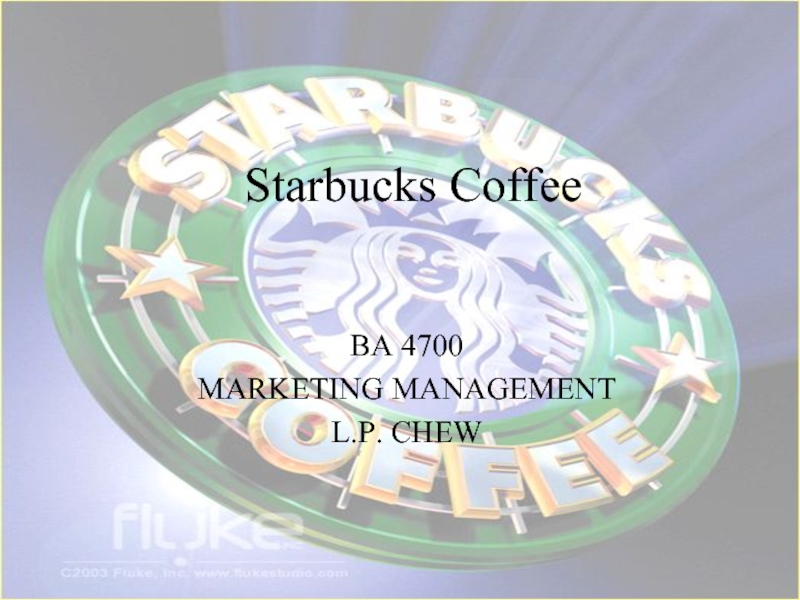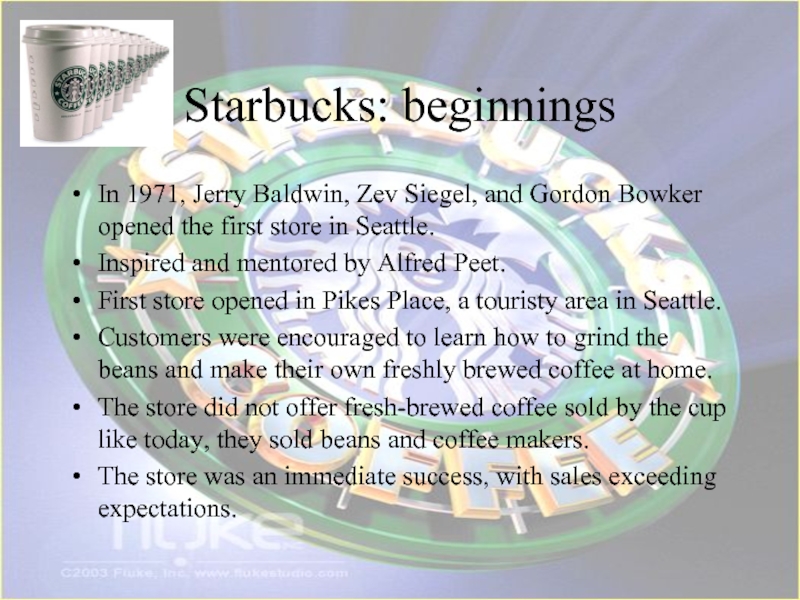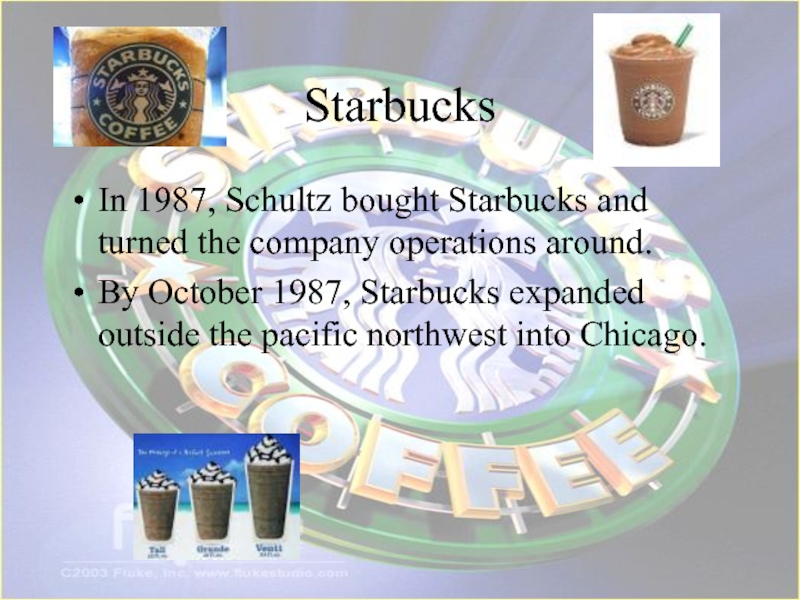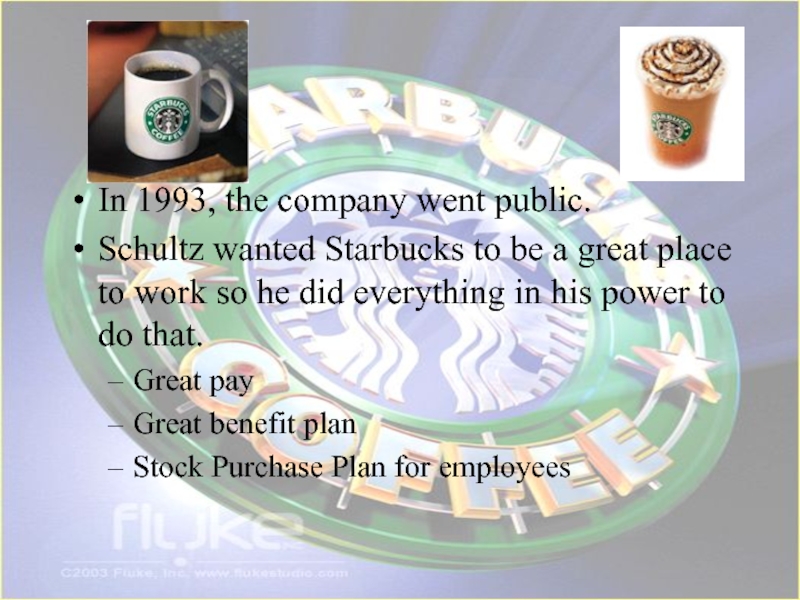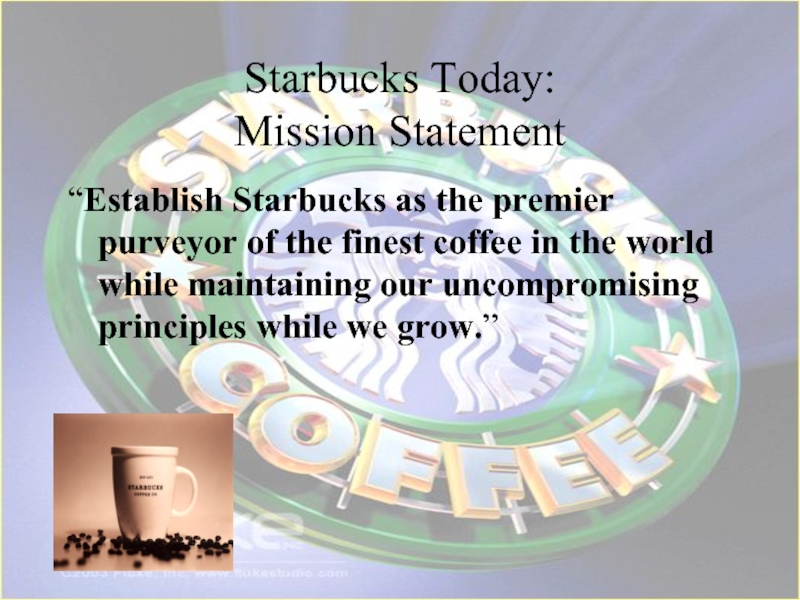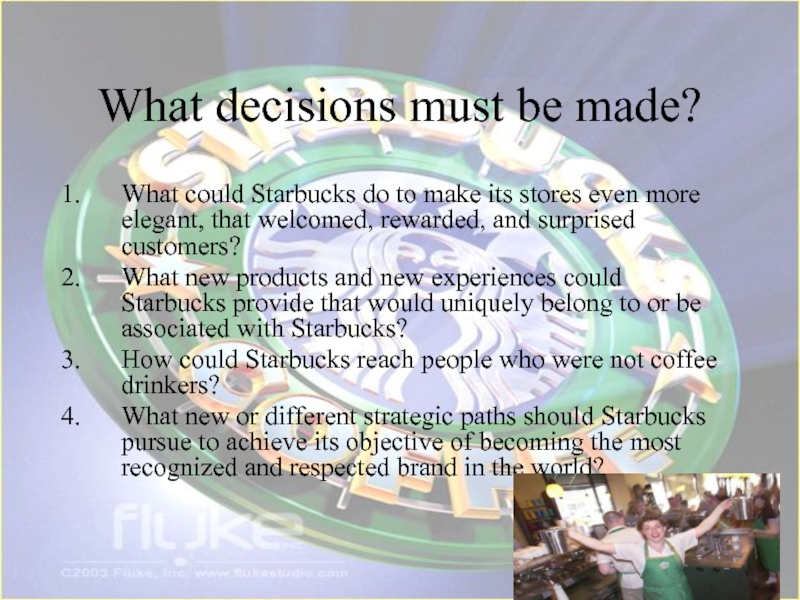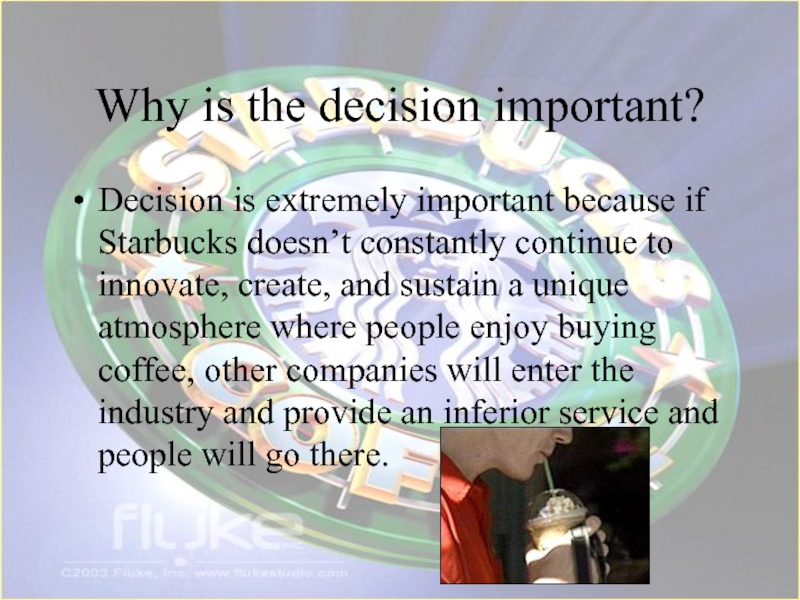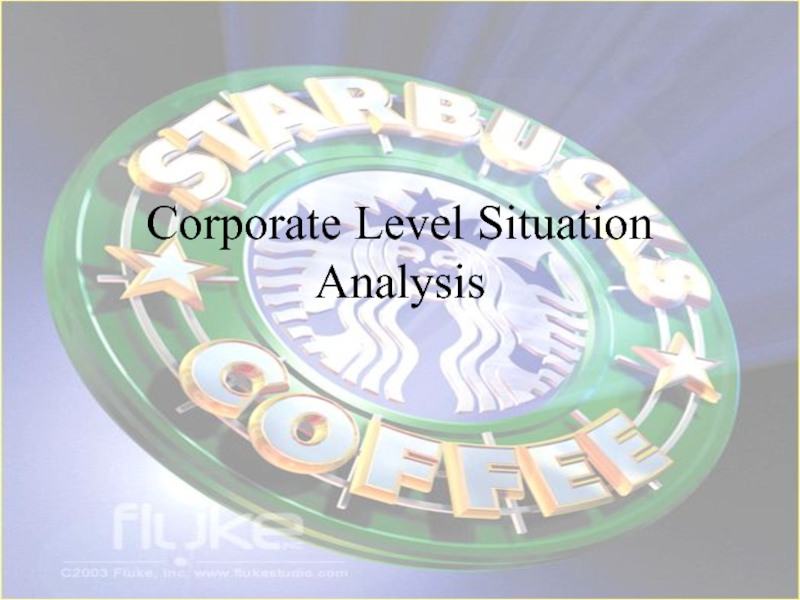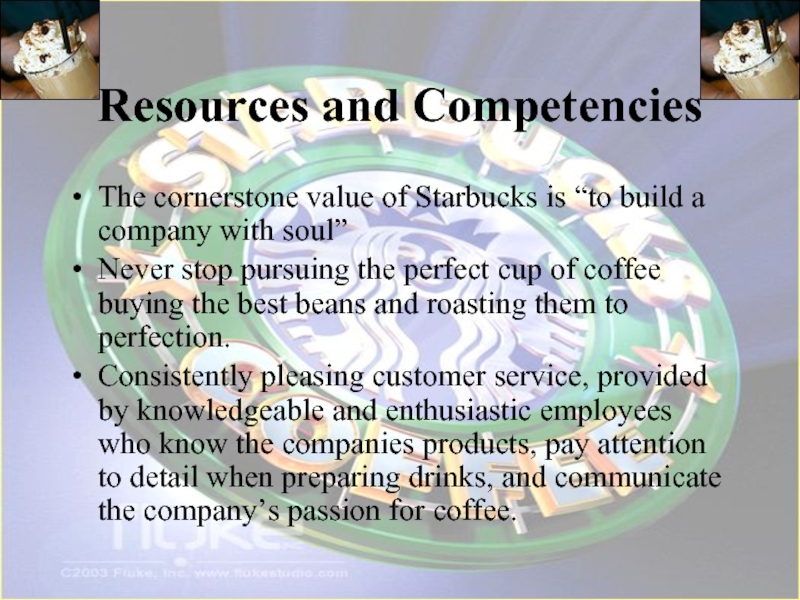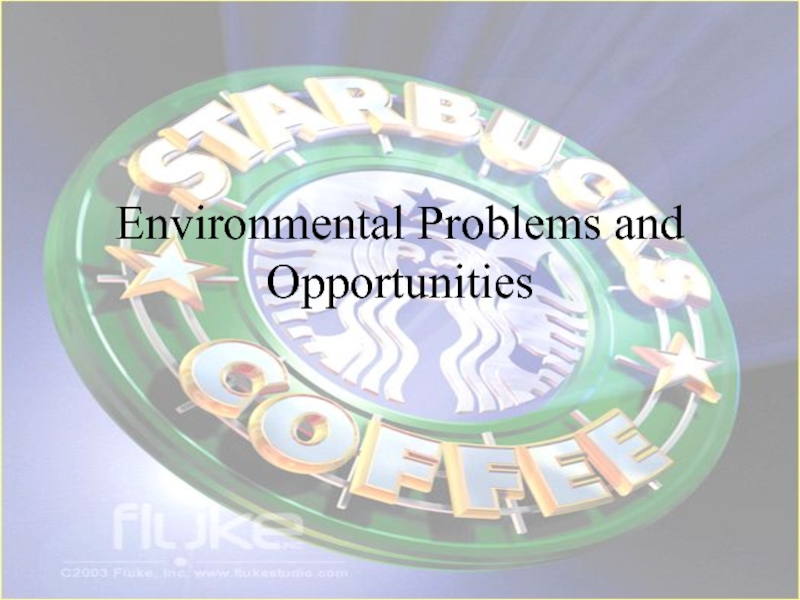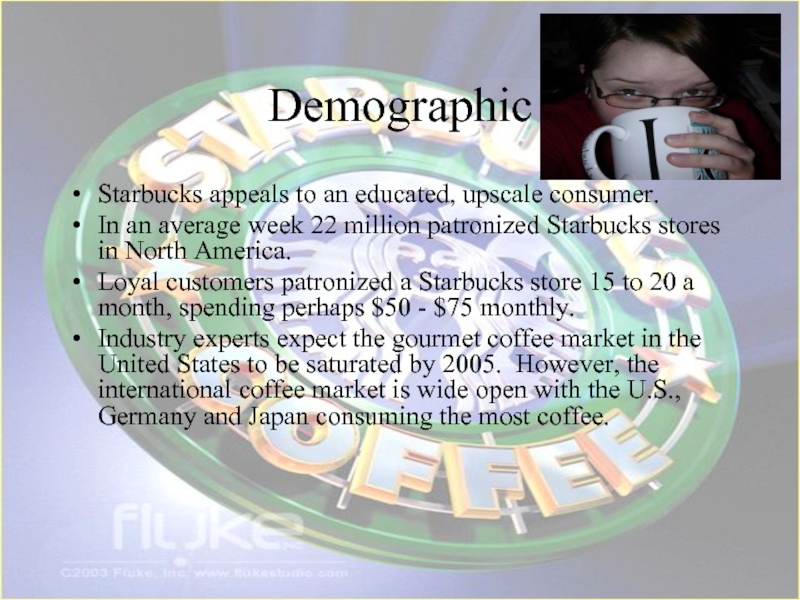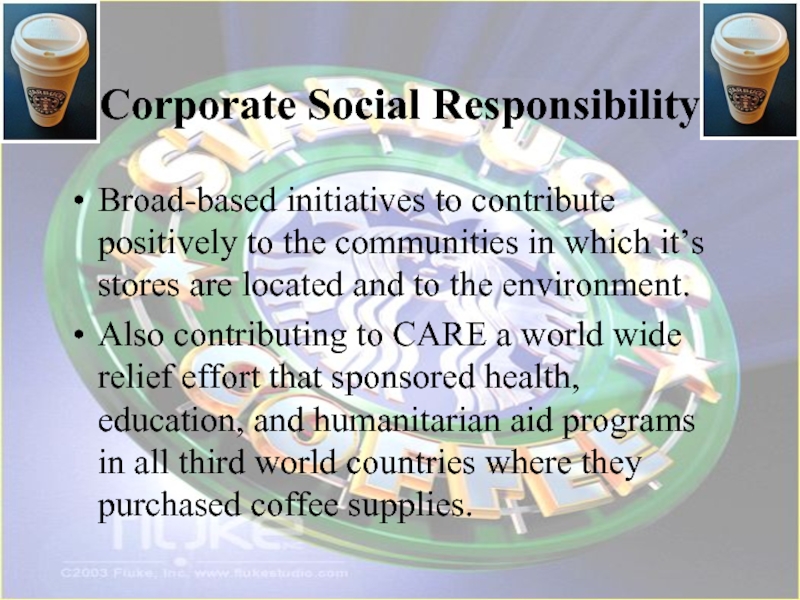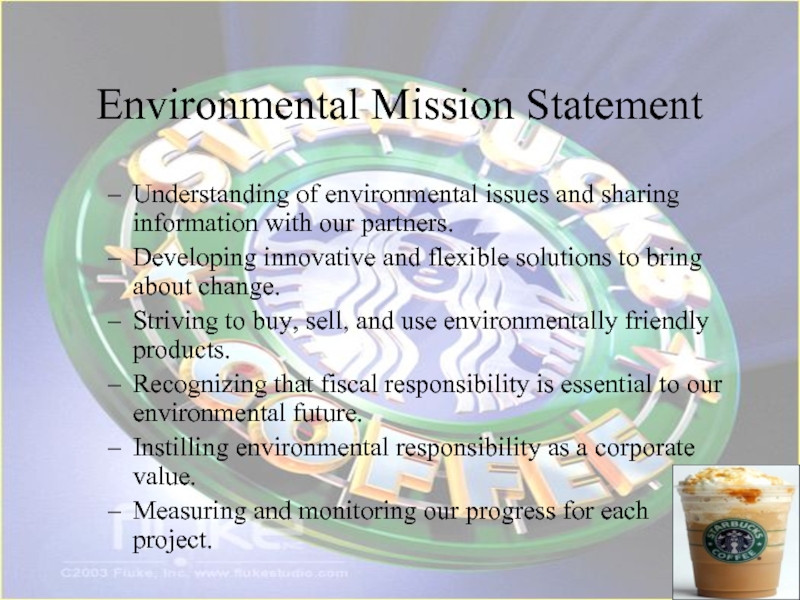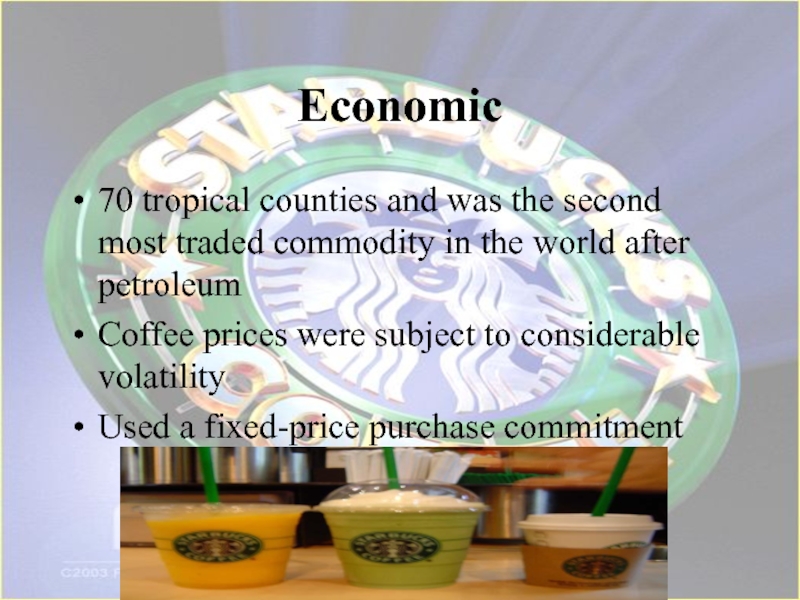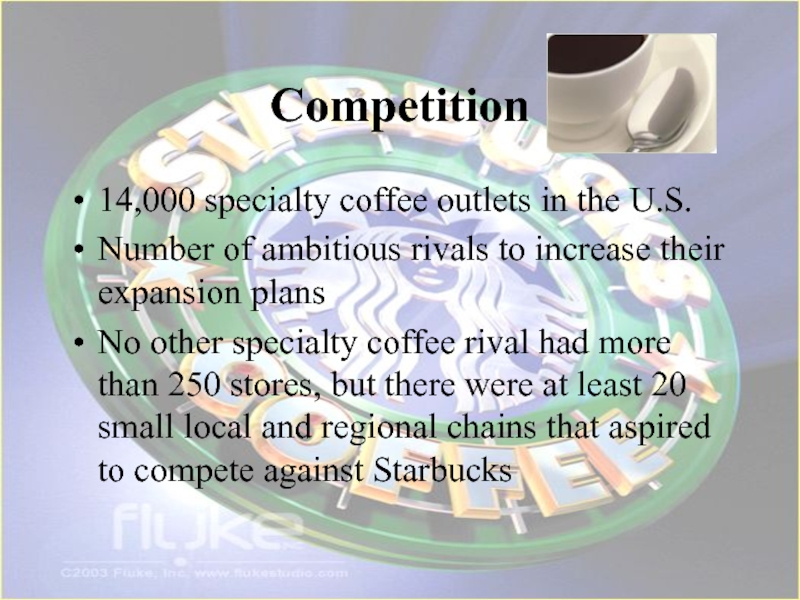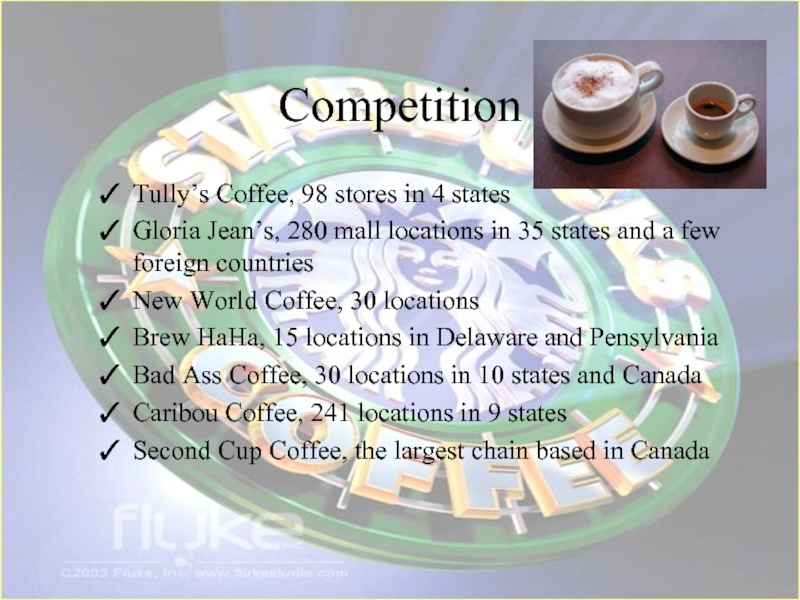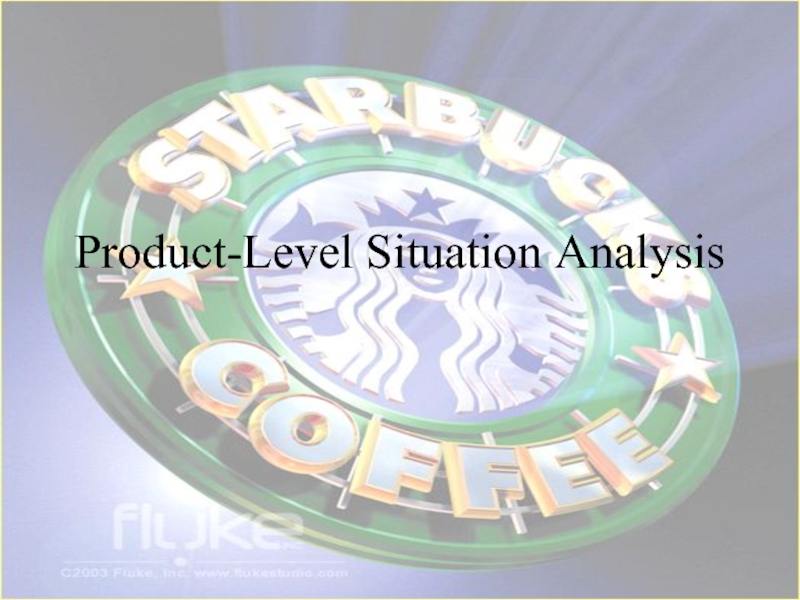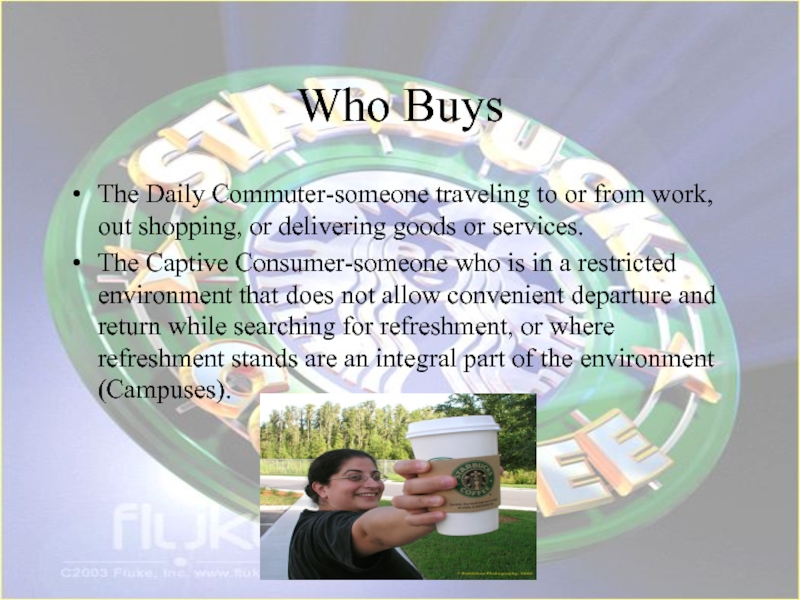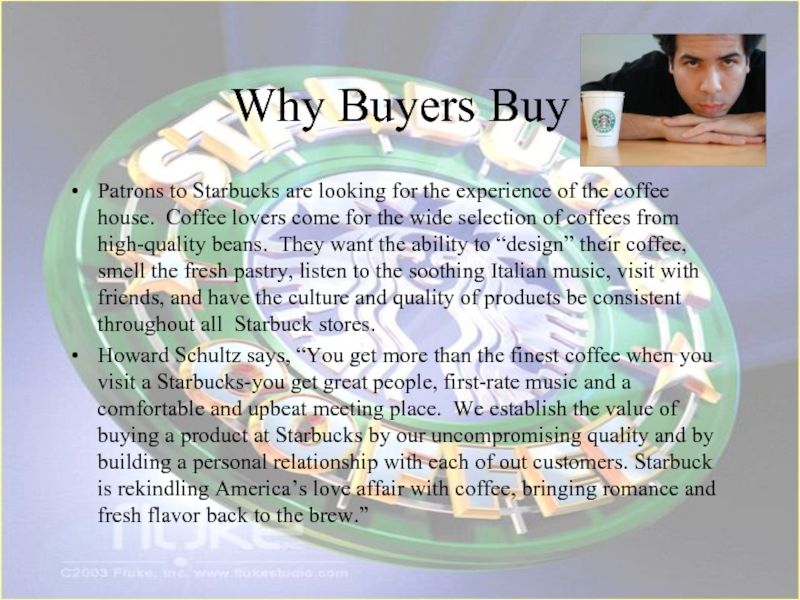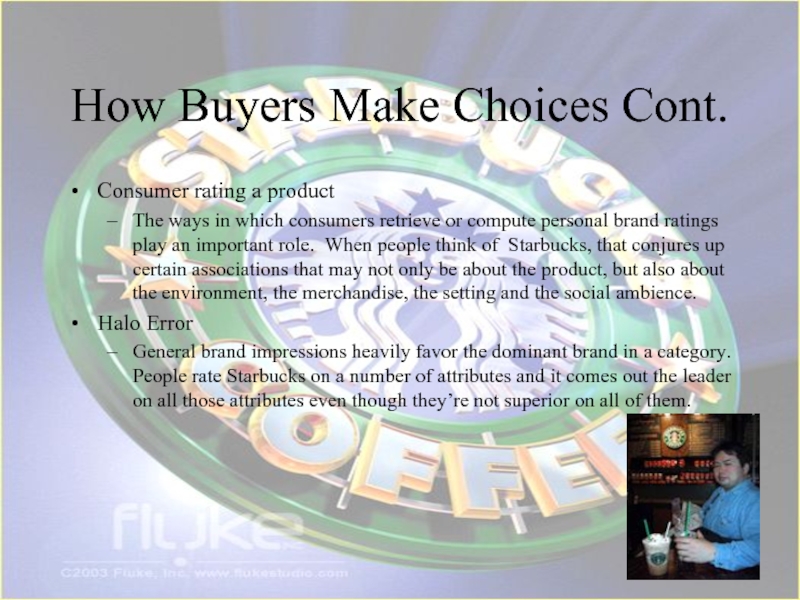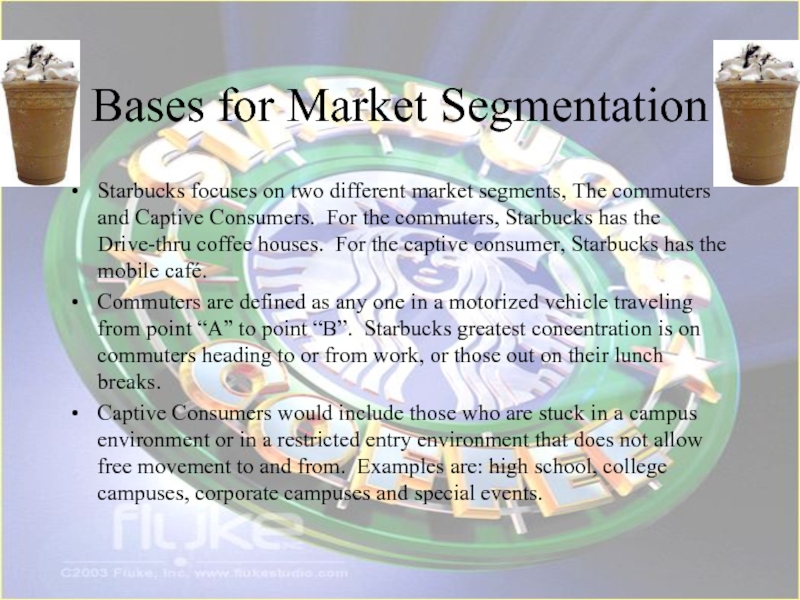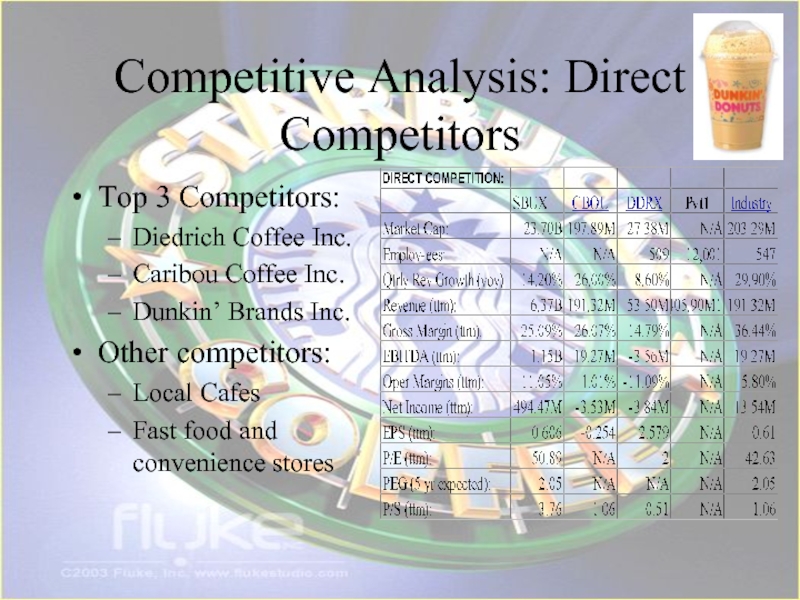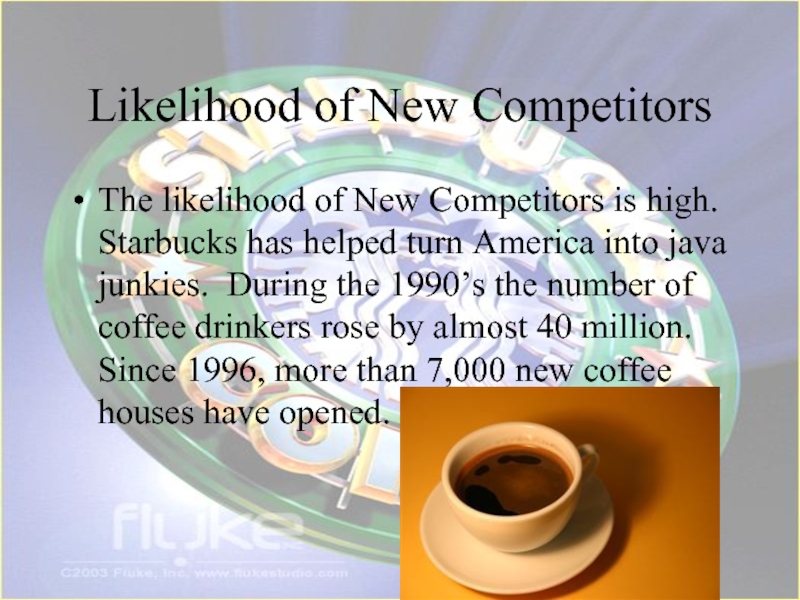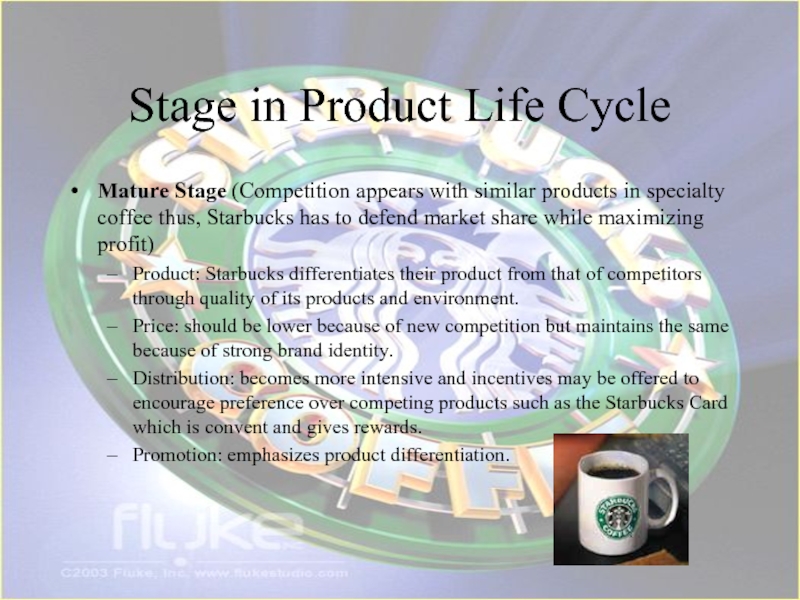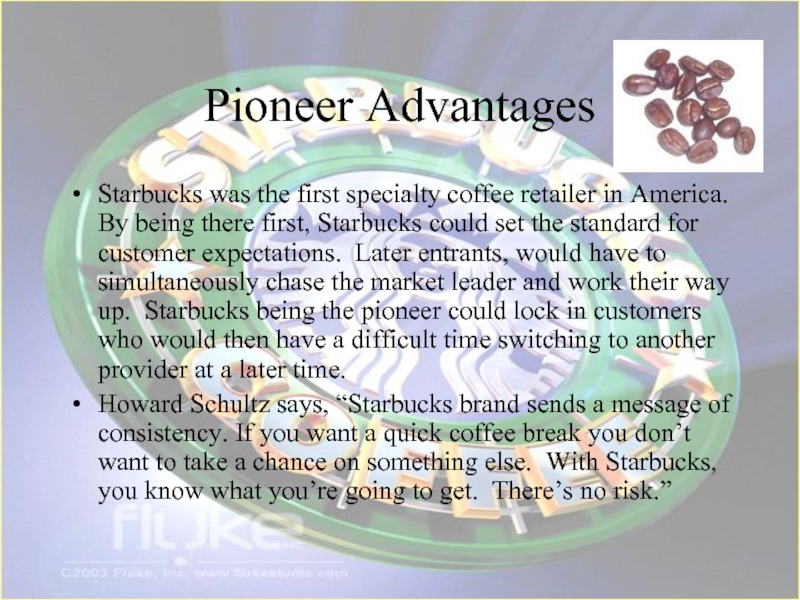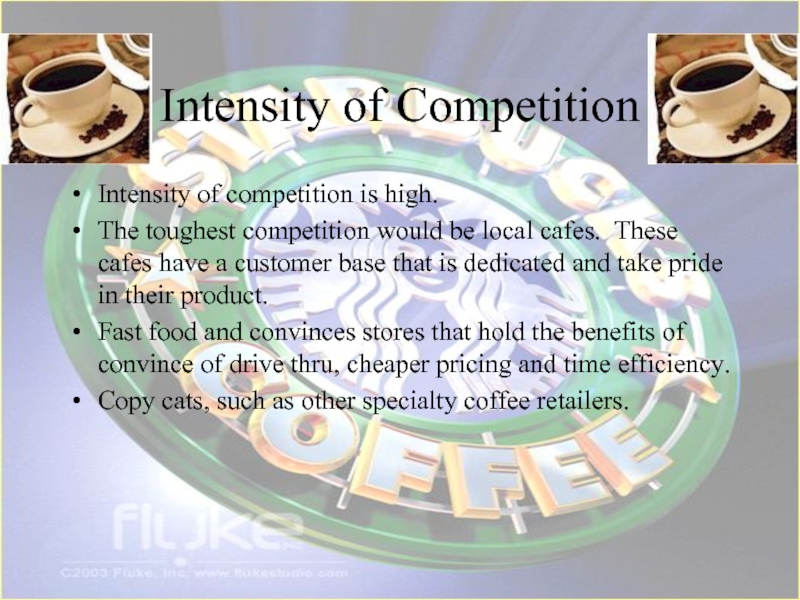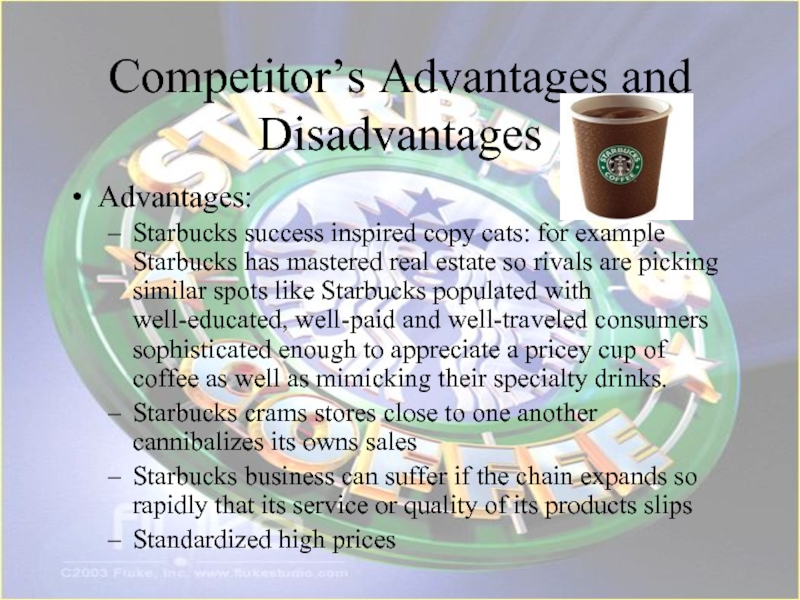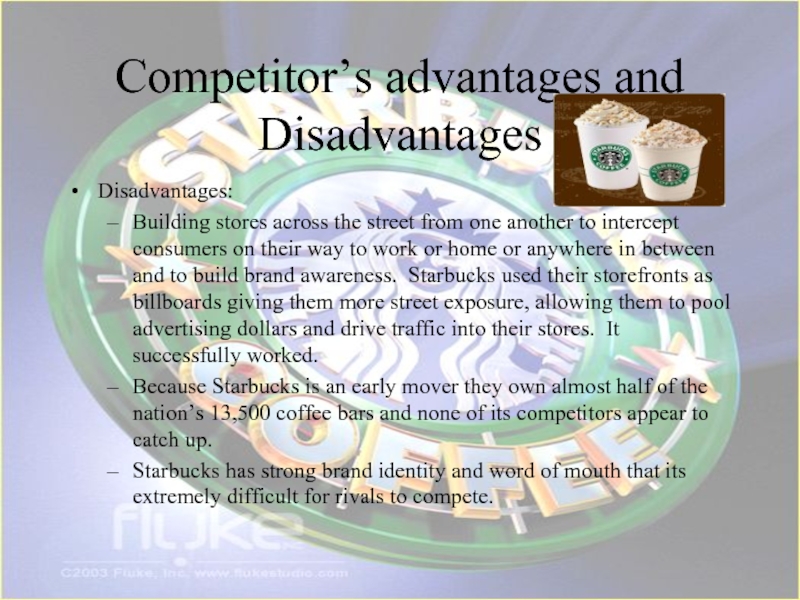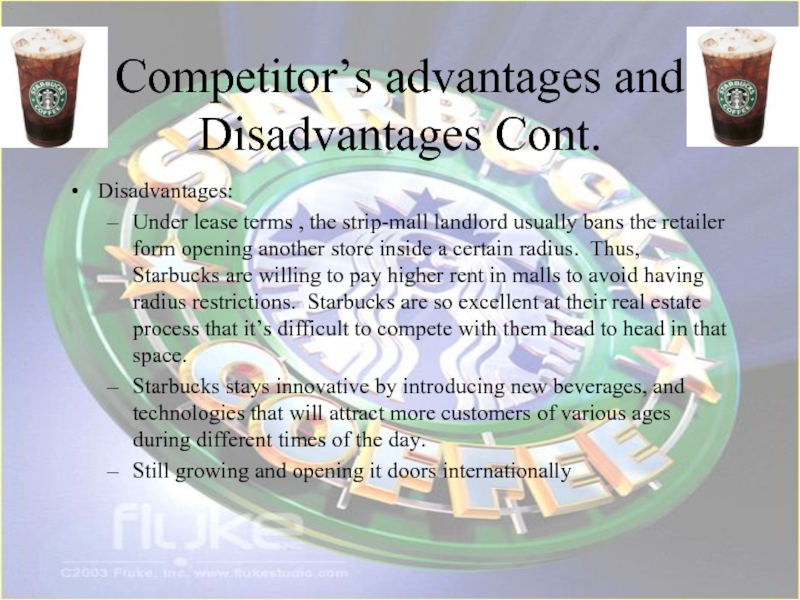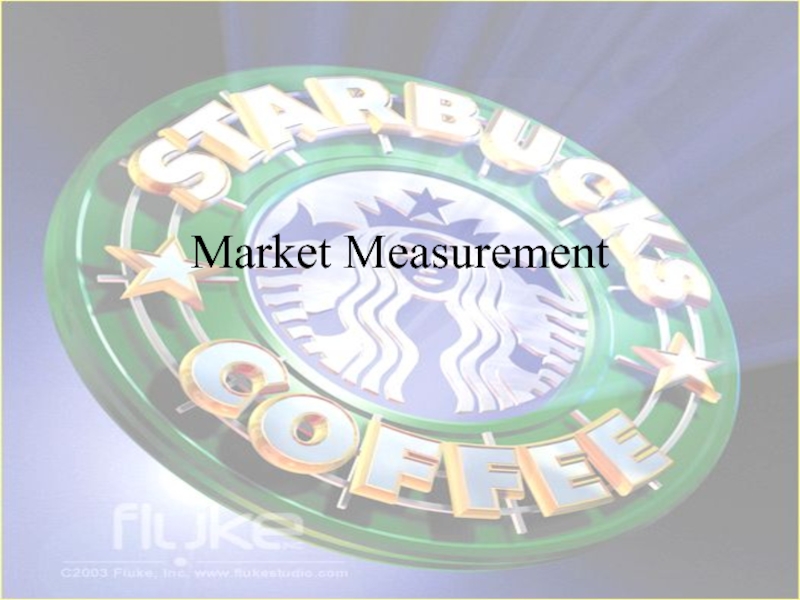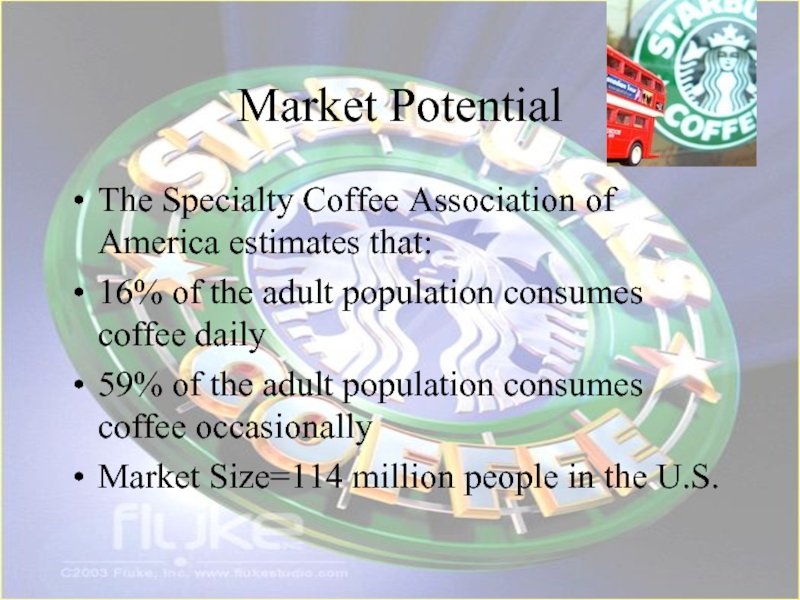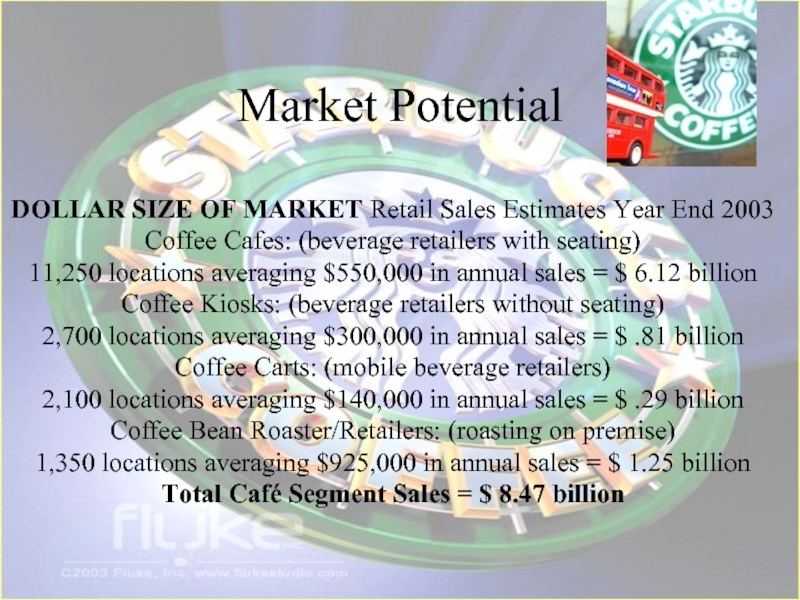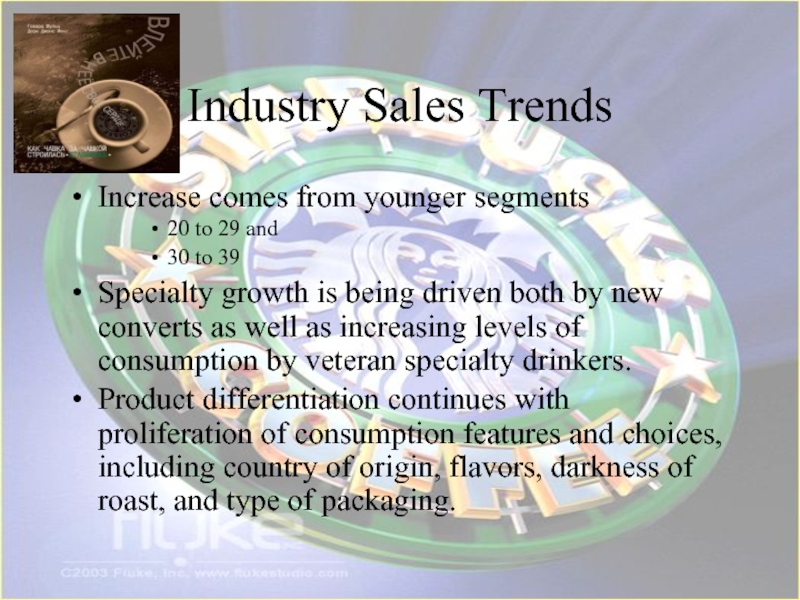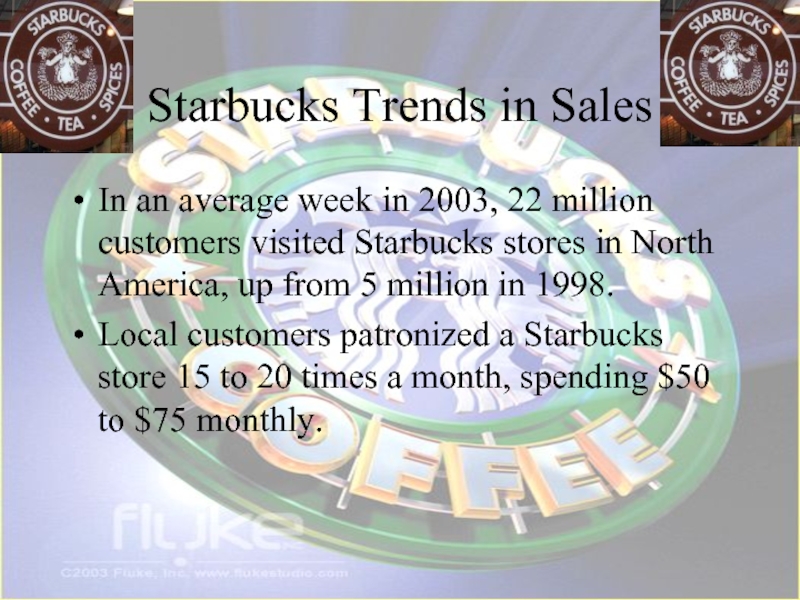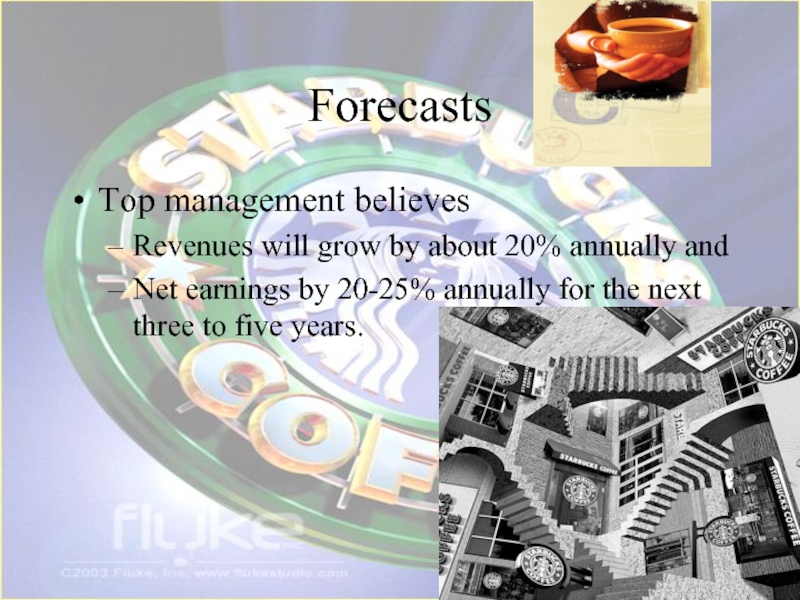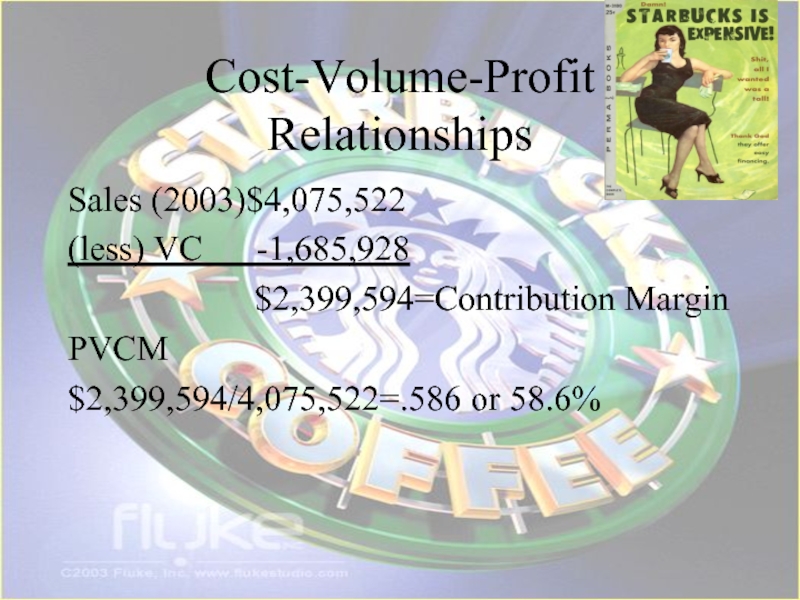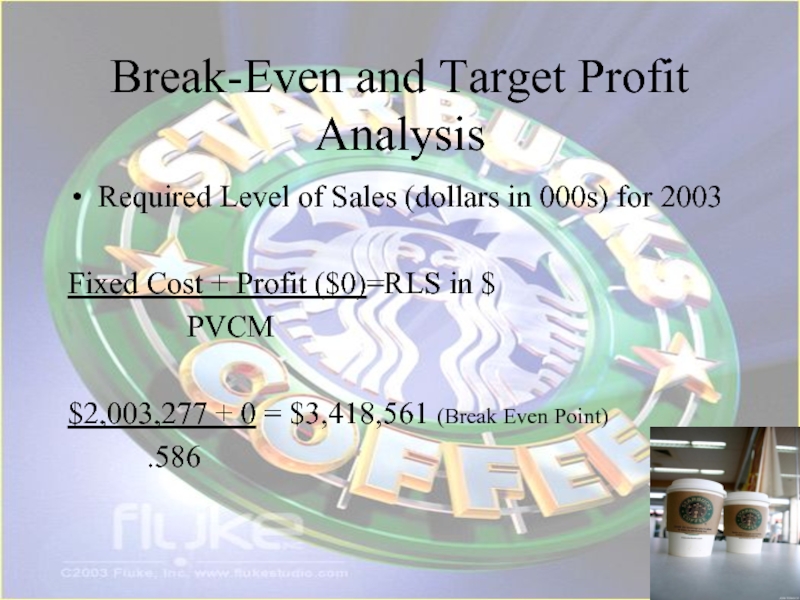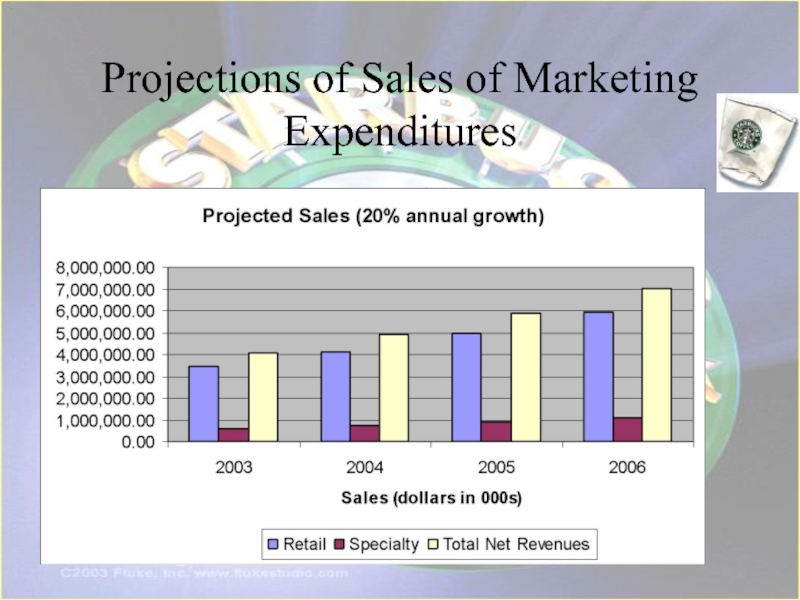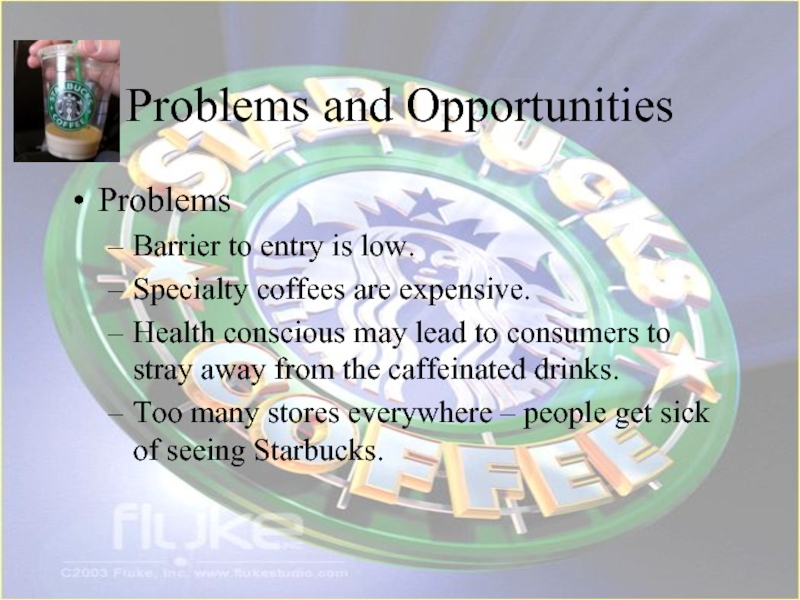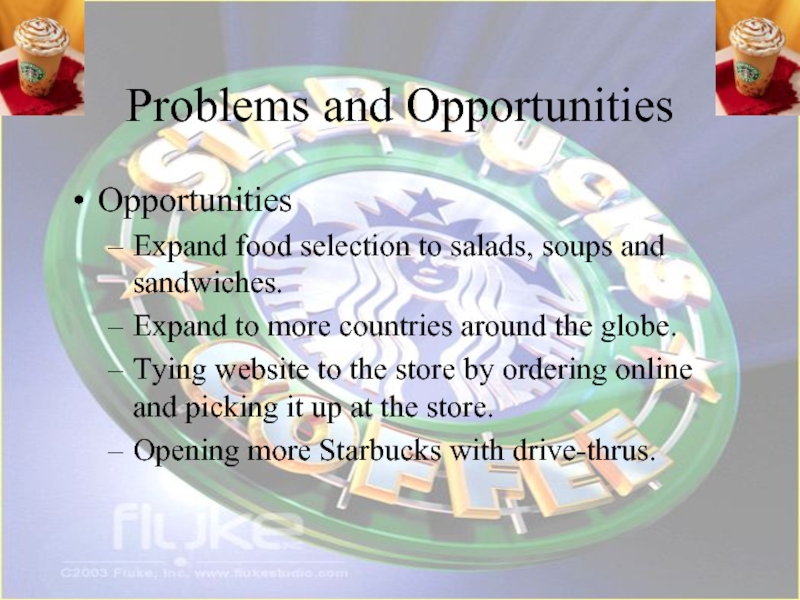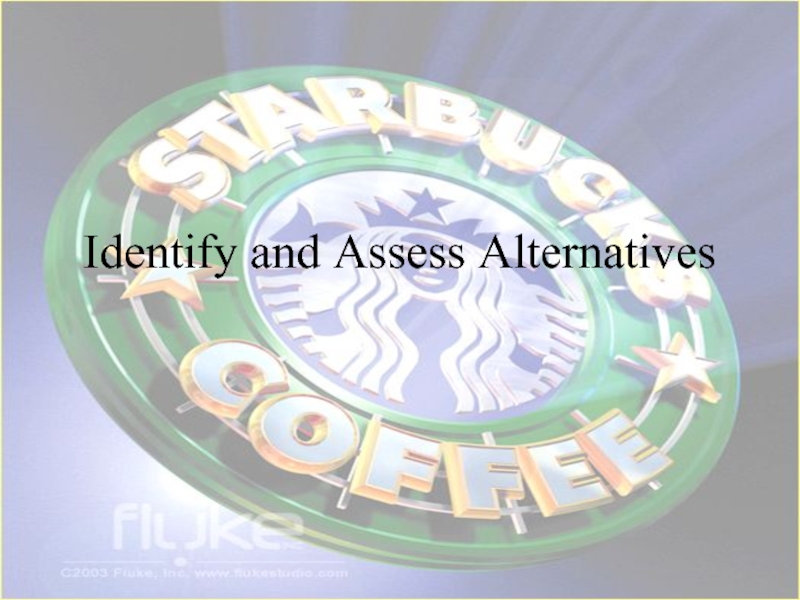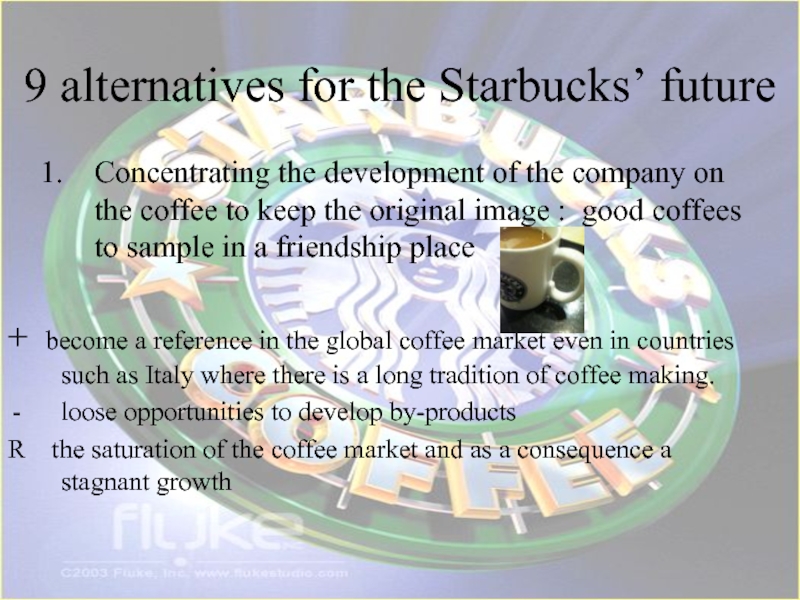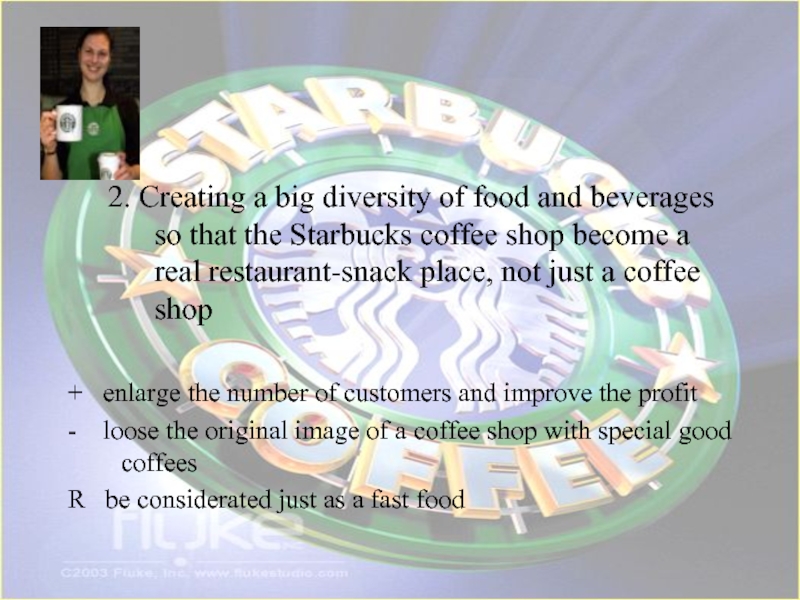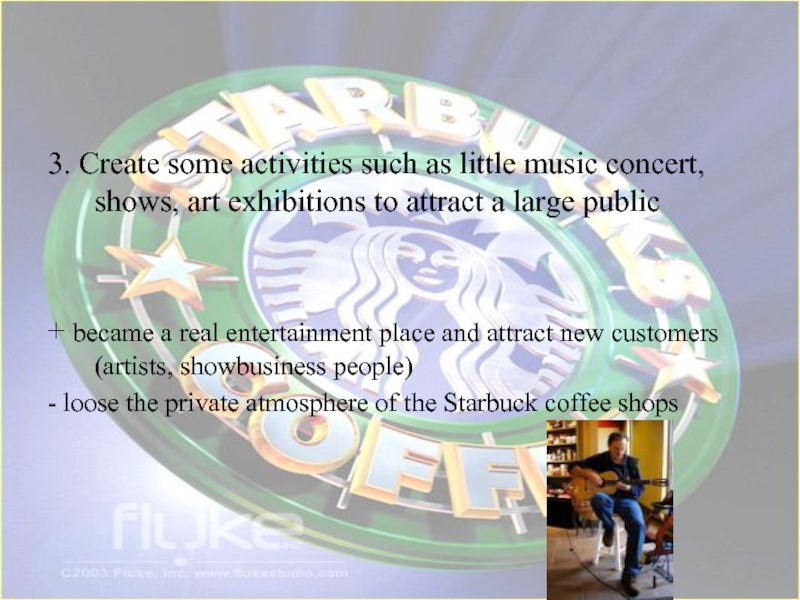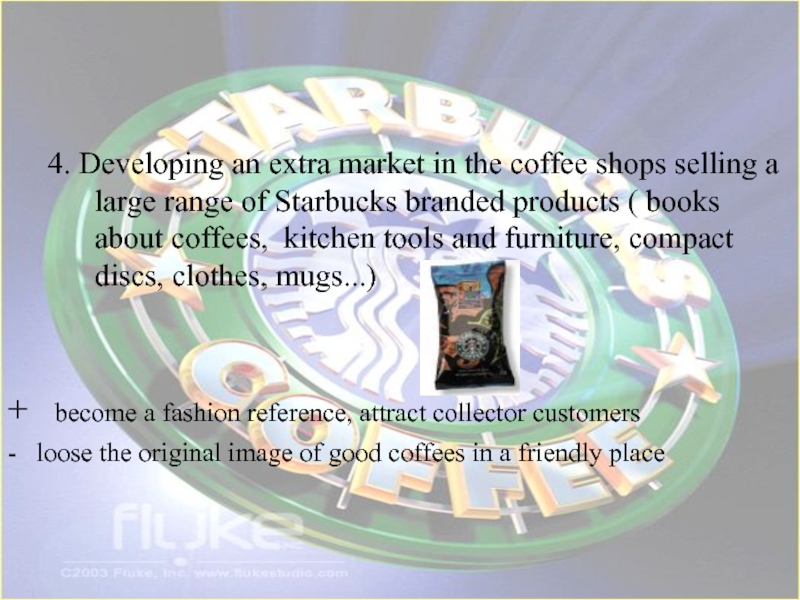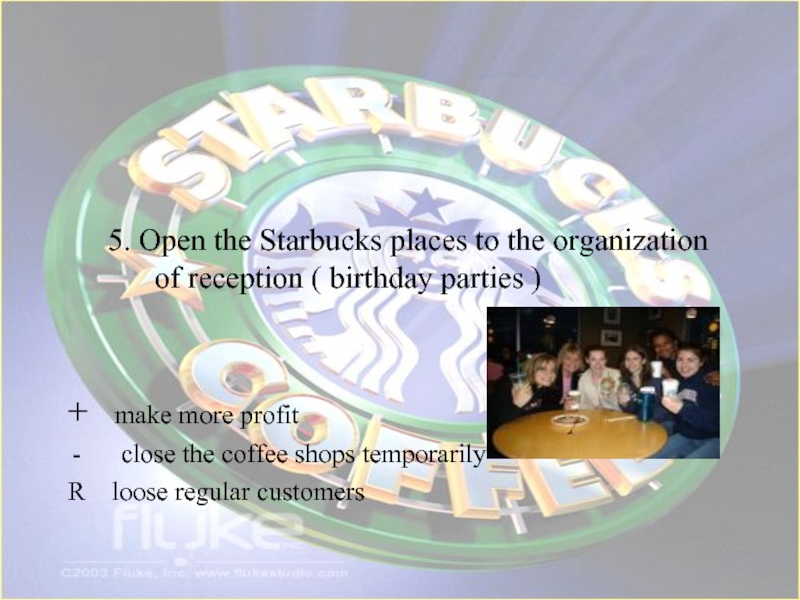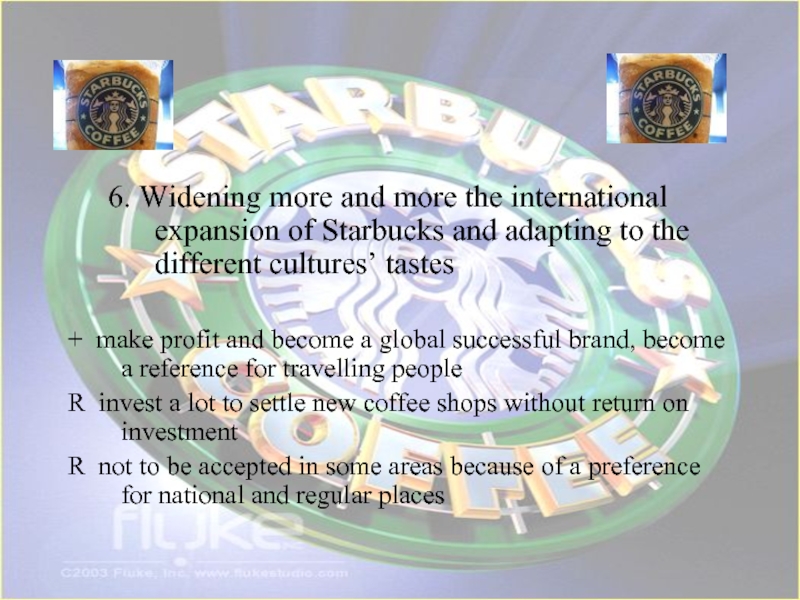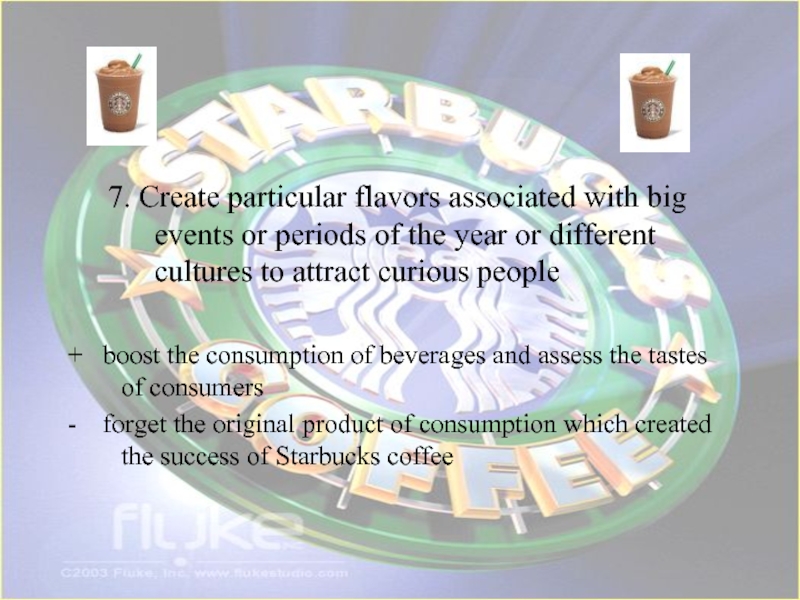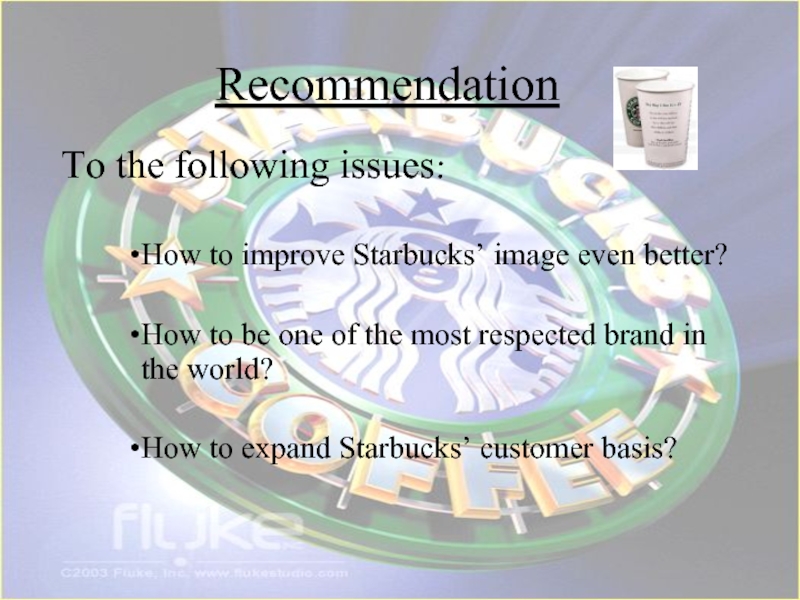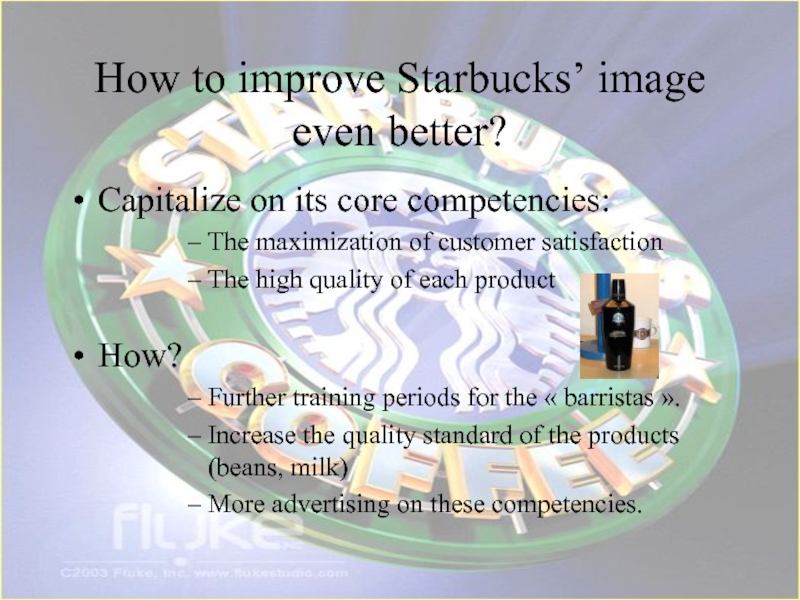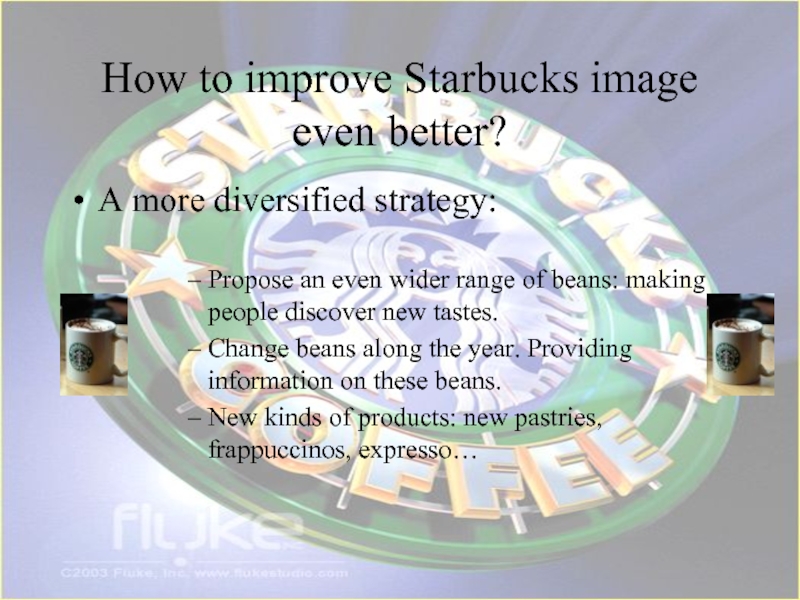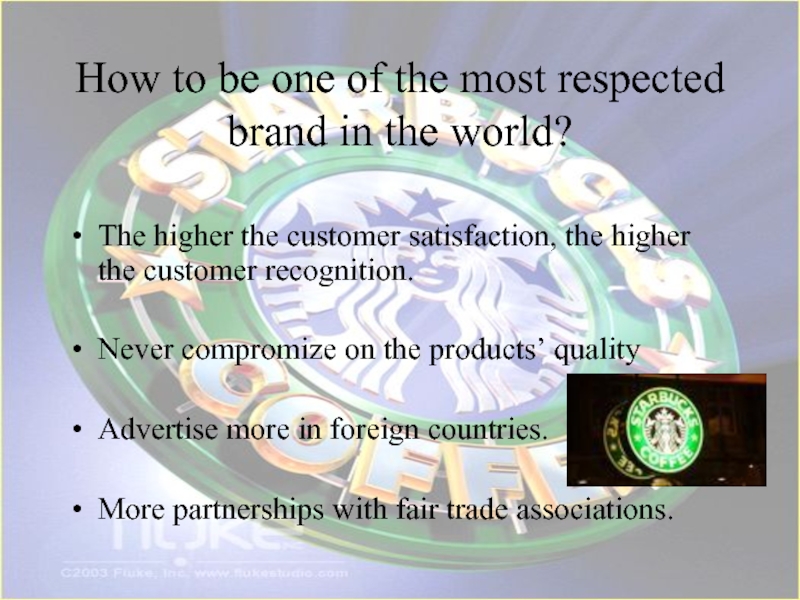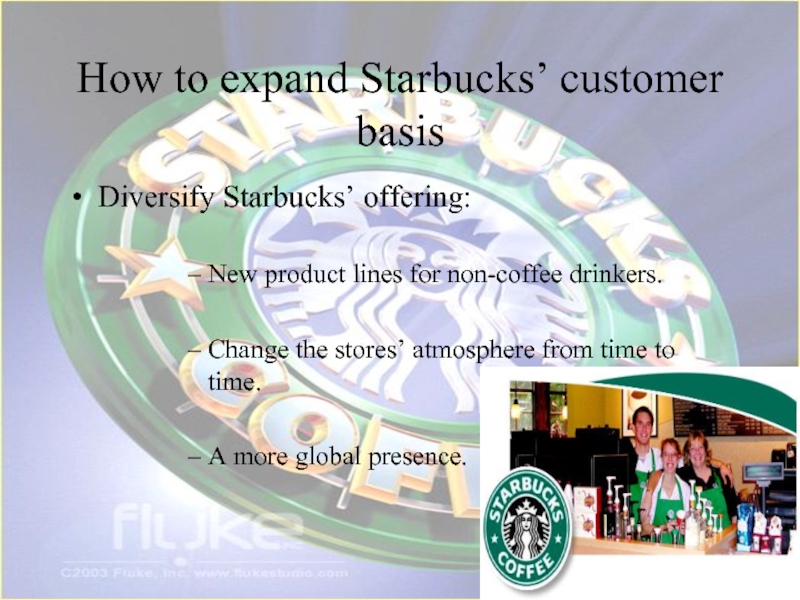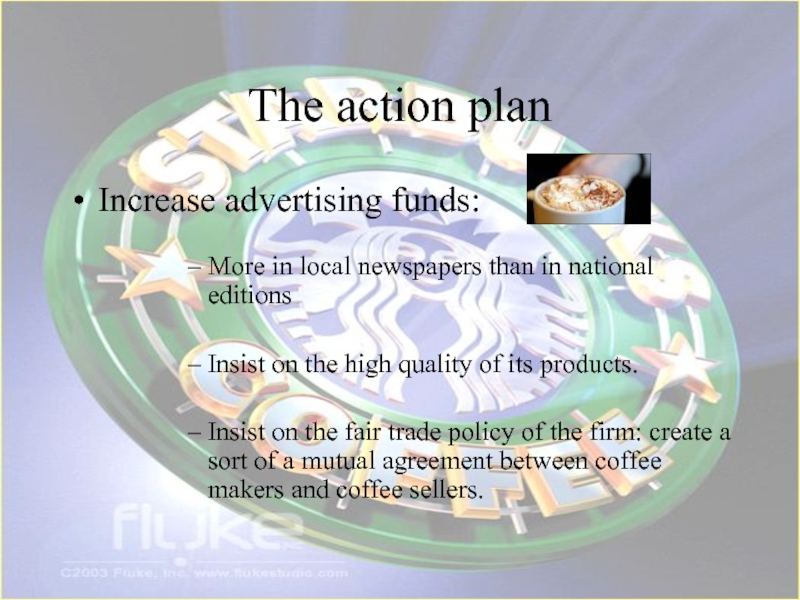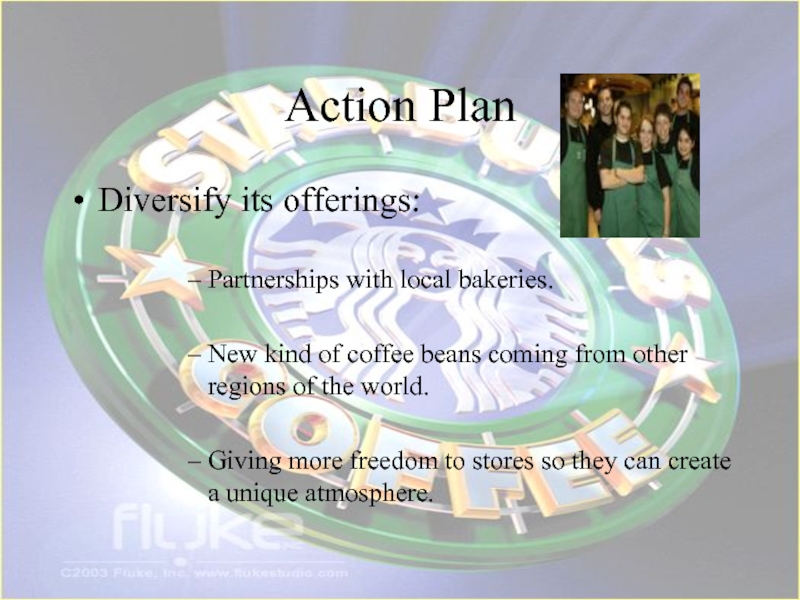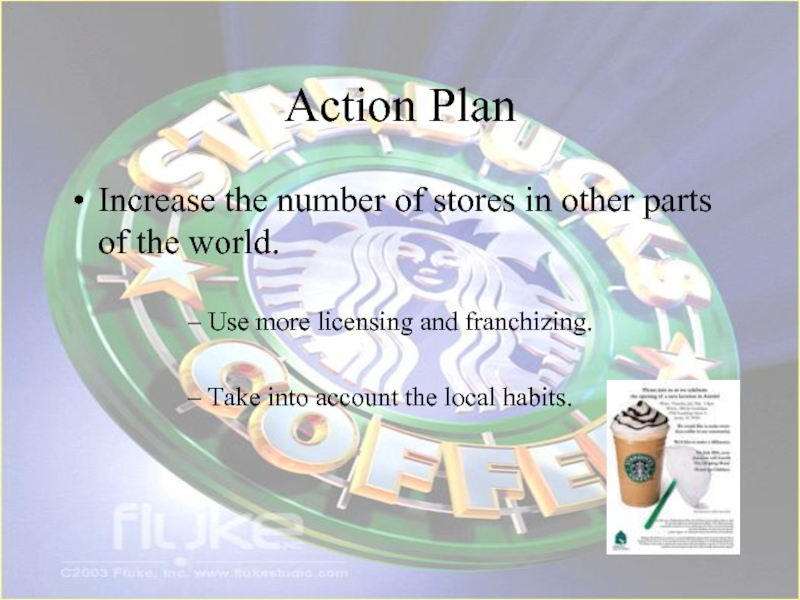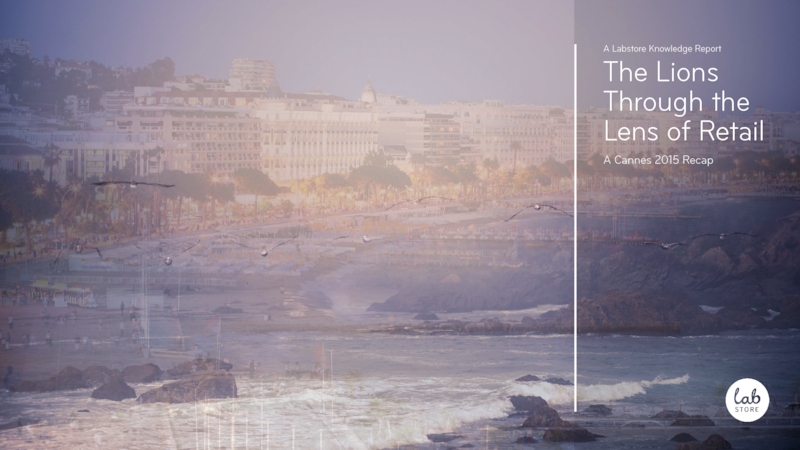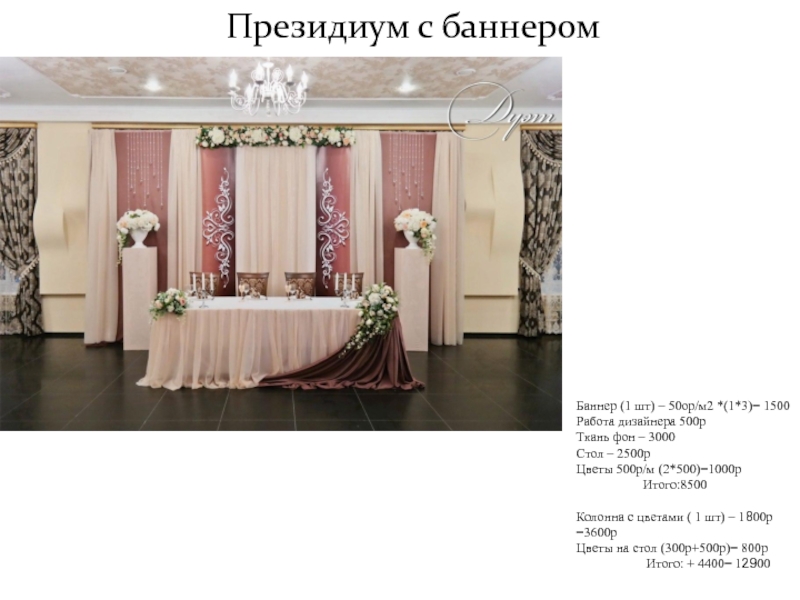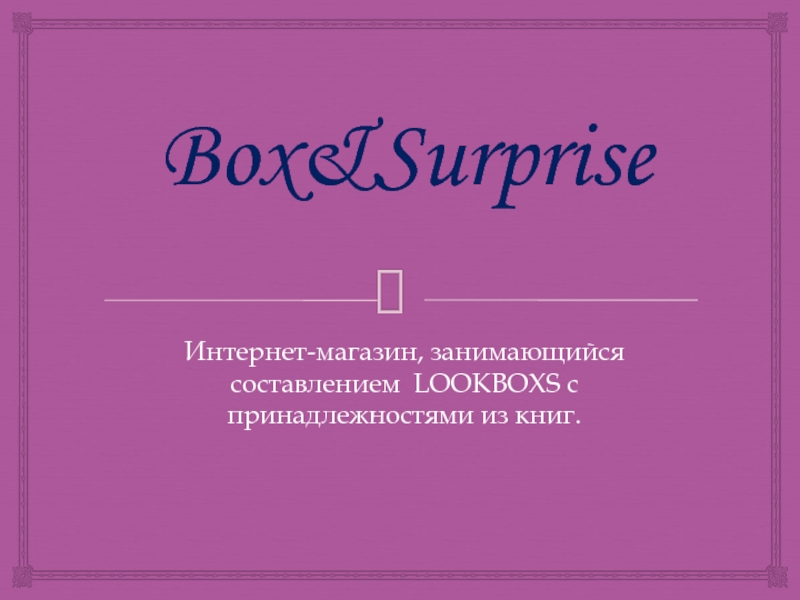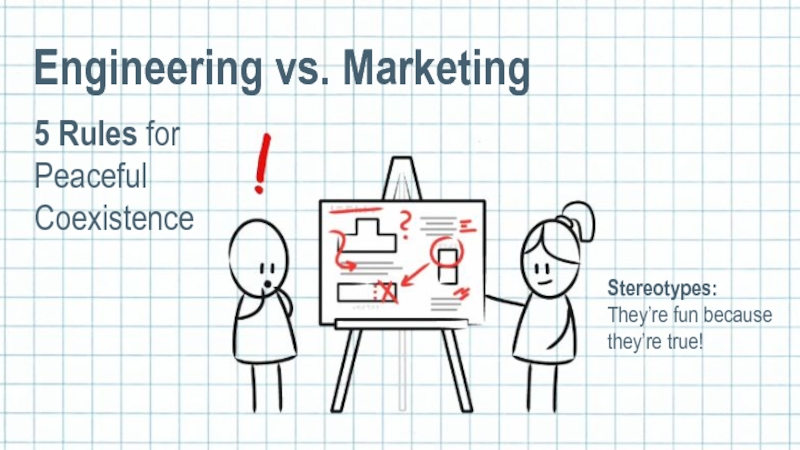- Главная
- Разное
- Дизайн
- Бизнес и предпринимательство
- Аналитика
- Образование
- Развлечения
- Красота и здоровье
- Финансы
- Государство
- Путешествия
- Спорт
- Недвижимость
- Армия
- Графика
- Культурология
- Еда и кулинария
- Лингвистика
- Английский язык
- Астрономия
- Алгебра
- Биология
- География
- Детские презентации
- Информатика
- История
- Литература
- Маркетинг
- Математика
- Медицина
- Менеджмент
- Музыка
- МХК
- Немецкий язык
- ОБЖ
- Обществознание
- Окружающий мир
- Педагогика
- Русский язык
- Технология
- Физика
- Философия
- Химия
- Шаблоны, картинки для презентаций
- Экология
- Экономика
- Юриспруденция
Starbucks coffee презентация
Содержание
- 1. Starbucks coffee
- 2. Starbucks: beginnings In 1971, Jerry Baldwin, Zev
- 3. Howard Schultz business man from New York
- 4. Starbucks In 1987, Schultz bought Starbucks and
- 5. In 1993, the company went public.
- 6. Starbucks Today: Mission Statement “Establish Starbucks as
- 7. Executive Officers chairman president and chief executive
- 8. What decisions must be made? What could
- 9. Why is the decision important? Decision is
- 10. What are potential consequences? Another company enters
- 11. Corporate Level Situation Analysis
- 12. Corporate Mission and Objectives Provide a
- 13. Resources and Competencies The cornerstone value
- 14. Environmental Problems and Opportunities
- 15. Demographic Starbucks appeals to an educated,
- 16. Corporate Social Responsibility Broad-based initiatives to
- 17. Environmental Mission Statement Understanding of environmental
- 18. Economic 70 tropical counties and was
- 19. Competition 14,000 specialty coffee outlets in
- 20. Competition Tully’s Coffee, 98 stores in
- 21. Product-Level Situation Analysis
- 22. Market Analysis: Product Market Structure Starbucks purchases
- 23. Who Buys The Daily Commuter-someone traveling to
- 24. Why Buyers Buy Patrons to Starbucks are
- 25. How Buyers Make Choices Customers make choices
- 26. How Buyers Make Choices Cont. Consumer rating
- 27. Bases for Market Segmentation Starbucks focuses on
- 28. Potential Target Markets China is the biggest
- 29. Competitive Analysis: Direct Competitors Top 3 Competitors:
- 30. Likelihood of New Competitors The likelihood of
- 31. Stage in Product Life Cycle Mature Stage
- 32. Pioneer Advantages Starbucks was the first specialty
- 33. Intensity of Competition Intensity of competition is
- 34. Competitor’s Advantages and Disadvantages Advantages: Starbucks success
- 35. Competitor’s advantages and Disadvantages Disadvantages: Building stores
- 36. Competitor’s advantages and Disadvantages Cont. Disadvantages: Under
- 37. Market Measurement
- 38. Market Potential The Specialty Coffee Association of
- 39. Market Potential DOLLAR SIZE OF
- 40. Industry Sales Trends Increase comes from younger
- 41. Starbucks Trends in Sales In an
- 42. Forecasts Top management believes Revenues will
- 43. Profitability and Productivity Analysis
- 44. Cost-Volume-Profit Relationships Sales (2003)$4,075,522 (less) VC
- 45. Break-Even and Target Profit Analysis Required Level
- 46. Projections of Sales of Marketing Expenditures
- 47. Problems and Opportunities Problems Barrier to entry
- 48. Problems and Opportunities Opportunities Expand food selection
- 49. Identify and Assess Alternatives
- 50. 9 alternatives for the Starbucks’ future Concentrating
- 51. 2. Creating a big diversity
- 52. 3. Create some activities
- 53. 4. Developing an extra market in
- 54. 5. Open the Starbucks
- 55. 6. Widening more and more
- 56. 7. Create particular flavors associated with
- 57. 8. Thinking about partnerships with
- 58. 9. Developing the brand in
- 59. Recommendation To the following issues:
- 60. How to improve Starbucks’ image even better?
- 61. How to improve Starbucks image even better?
- 62. How to be one of the most
- 63. How to expand Starbucks’ customer basis Diversify
- 64. The action plan Increase advertising funds:
- 65. Action Plan Diversify its offerings: Partnerships
- 66. Action Plan Increase the number of stores
Слайд 2Starbucks: beginnings
In 1971, Jerry Baldwin, Zev Siegel, and Gordon Bowker opened
Inspired and mentored by Alfred Peet.
First store opened in Pikes Place, a touristy area in Seattle.
Customers were encouraged to learn how to grind the beans and make their own freshly brewed coffee at home.
The store did not offer fresh-brewed coffee sold by the cup like today, they sold beans and coffee makers.
The store was an immediate success, with sales exceeding expectations.
Слайд 3Howard Schultz
business man from New York visited Starbucks in 1981.
Pursued a
Schultz had a vision for Starbucks:
Wanted to expand the company
Visited Italy and loved the concept of the Italian Bar
Starbucks owner did not have the same vision for Starbucks
Schultz left Starbucks to open Il Giornale, a coffee bar based on what he saw in Italy.
Слайд 4Starbucks
In 1987, Schultz bought Starbucks and turned the company operations around.
By
Слайд 5
In 1993, the company went public.
Schultz wanted Starbucks to be a
Great pay
Great benefit plan
Stock Purchase Plan for employees
Слайд 6Starbucks Today:
Mission Statement
“Establish Starbucks as the premier purveyor of the finest
Слайд 7Executive Officers
chairman
president and chief executive officer
president, Starbucks Coffee International
president, Starbucks Coffee
evp, general counsel and secretary
evp, chief financial officer, chief administrative officer
evp, Supply Chain and Coffee Operations
evp, Partner Resources
svp, Finance
svp and managing director, United Kingdom
svp, chief information officer
svp, and president, Asia Pacific
svp, Category Management
svp, Partner Resources, Starbucks Coffee International
svp, North America Partner Resources
svp, and president, Europe, Middle East, Africa
svp, Coffee and Global Procurement
svp, and president, Latin America
svp, Global Communications
svp, Emerging Businesses
Howard Schultz
Jim Donald
Martin Coles
Jim Alling
Paula Boggs
Michael Casey
Dorothy Kim
David Pace
Troy Alstead
Cliff Burrows
Brian Crynes
Christine Day
Michelle Gass
Tony George
Margie Giuntini
Julio Gutiérrez
Willard (Dub) Hay
Buck Hendrix
Wanda Herndon
Gregg Johnson
Слайд 8What decisions must be made?
What could Starbucks do to make its
What new products and new experiences could Starbucks provide that would uniquely belong to or be associated with Starbucks?
How could Starbucks reach people who were not coffee drinkers?
What new or different strategic paths should Starbucks pursue to achieve its objective of becoming the most recognized and respected brand in the world?
Слайд 9Why is the decision important?
Decision is extremely important because if Starbucks
Слайд 10What are potential consequences?
Another company enters the market and overthrows Starbucks
People become even more health-conscious and decrease the frequency of their caffeine-ated drinks.
Regular coffee as oppose to gourmet coffee will attract more consumers.
Слайд 12Corporate Mission and Objectives
Provide a great work environment and treat
Embrace diversity as an essential component in the way we do business.
Apply the highest standards of excellence to the purchasing, roasting , and fresh delivery of our coffee
Develop enthusiastically satisfied customers all of the time.
Contribute positively to our communities and our environment.
Recognize that profitability is essential to our future success.
Слайд 13Resources and Competencies
The cornerstone value of Starbucks is “to build
Never stop pursuing the perfect cup of coffee buying the best beans and roasting them to perfection.
Consistently pleasing customer service, provided by knowledgeable and enthusiastic employees who know the companies products, pay attention to detail when preparing drinks, and communicate the company’s passion for coffee.
Слайд 15Demographic
Starbucks appeals to an educated, upscale consumer.
In an average
Loyal customers patronized a Starbucks store 15 to 20 a month, spending perhaps $50 - $75 monthly.
Industry experts expect the gourmet coffee market in the United States to be saturated by 2005. However, the international coffee market is wide open with the U.S., Germany and Japan consuming the most coffee.
Слайд 16Corporate Social Responsibility
Broad-based initiatives to contribute positively to the communities
Also contributing to CARE a world wide relief effort that sponsored health, education, and humanitarian aid programs in all third world countries where they purchased coffee supplies.
Слайд 17Environmental Mission Statement
Understanding of environmental issues and sharing information with
Developing innovative and flexible solutions to bring about change.
Striving to buy, sell, and use environmentally friendly products.
Recognizing that fiscal responsibility is essential to our environmental future.
Instilling environmental responsibility as a corporate value.
Measuring and monitoring our progress for each project.
Слайд 18Economic
70 tropical counties and was the second most traded commodity
Coffee prices were subject to considerable volatility
Used a fixed-price purchase commitment
Слайд 19Competition
14,000 specialty coffee outlets in the U.S.
Number of ambitious
No other specialty coffee rival had more than 250 stores, but there were at least 20 small local and regional chains that aspired to compete against Starbucks
Слайд 20Competition
Tully’s Coffee, 98 stores in 4 states
Gloria Jean’s, 280 mall
New World Coffee, 30 locations
Brew HaHa, 15 locations in Delaware and Pensylvania
Bad Ass Coffee, 30 locations in 10 states and Canada
Caribou Coffee, 241 locations in 9 states
Second Cup Coffee, the largest chain based in Canada
Слайд 22Market Analysis: Product Market Structure
Starbucks purchases and roasts high-quality, whole bean,
Starbucks produces and sells bottled Frappuccino coffee drinks, Starbucks DoubleShot coffee drink
An exclusive line of Starbucks Barista home espresso machines, coffee brewers and grinders
Offers a line of innovative premium teas produced by Tazo Tea Company
A line of super premium ice cream, premium chocolate, sandwiches, salads
Coffee mugs, compact discs and assorted gift items
The Starbucks Card a reloadable stored-value card
The Company’s objective is to establish Starbucks as the most recognized and respected brand in the world.
Слайд 23Who Buys
The Daily Commuter-someone traveling to or from work, out shopping,
The Captive Consumer-someone who is in a restricted environment that does not allow convenient departure and return while searching for refreshment, or where refreshment stands are an integral part of the environment (Campuses).
Слайд 24Why Buyers Buy
Patrons to Starbucks are looking for the experience of
Howard Schultz says, “You get more than the finest coffee when you visit a Starbucks-you get great people, first-rate music and a comfortable and upbeat meeting place. We establish the value of buying a product at Starbucks by our uncompromising quality and by building a personal relationship with each of out customers. Starbuck is rekindling America’s love affair with coffee, bringing romance and fresh flavor back to the brew.”
Слайд 25How Buyers Make Choices
Customers make choices based on their aspects of
Brand effect- Consumer will pay extra for a cup of Starbucks coffee simply because it’s Starbucks, and not because the product is better.
Product effect- If the consumer believes that Starbucks uses a higher-quality bean or that the brewing methods produce a better-tasting coffee.
Слайд 26How Buyers Make Choices Cont.
Consumer rating a product
The ways in which
Halo Error
General brand impressions heavily favor the dominant brand in a category. People rate Starbucks on a number of attributes and it comes out the leader on all those attributes even though they’re not superior on all of them.
Слайд 27Bases for Market Segmentation
Starbucks focuses on two different market segments, The
Commuters are defined as any one in a motorized vehicle traveling from point “A” to point “B”. Starbucks greatest concentration is on commuters heading to or from work, or those out on their lunch breaks.
Captive Consumers would include those who are stuck in a campus environment or in a restricted entry environment that does not allow free movement to and from. Examples are: high school, college campuses, corporate campuses and special events.
Слайд 28Potential Target Markets
China is the biggest potential market
Since Starbucks opened its
China has a large urban population, rising economy and increase in coffee consumption
Слайд 29Competitive Analysis: Direct Competitors
Top 3 Competitors:
Diedrich Coffee Inc.
Caribou Coffee Inc.
Dunkin’ Brands
Other competitors:
Local Cafes
Fast food and convenience stores
Слайд 30Likelihood of New Competitors
The likelihood of New Competitors is high. Starbucks
Слайд 31Stage in Product Life Cycle
Mature Stage (Competition appears with similar products
Product: Starbucks differentiates their product from that of competitors through quality of its products and environment.
Price: should be lower because of new competition but maintains the same because of strong brand identity.
Distribution: becomes more intensive and incentives may be offered to encourage preference over competing products such as the Starbucks Card which is convent and gives rewards.
Promotion: emphasizes product differentiation.
Слайд 32Pioneer Advantages
Starbucks was the first specialty coffee retailer in America. By
Howard Schultz says, “Starbucks brand sends a message of consistency. If you want a quick coffee break you don’t want to take a chance on something else. With Starbucks, you know what you’re going to get. There’s no risk.”
Слайд 33Intensity of Competition
Intensity of competition is high.
The toughest competition would be
Fast food and convinces stores that hold the benefits of convince of drive thru, cheaper pricing and time efficiency.
Copy cats, such as other specialty coffee retailers.
Слайд 34Competitor’s Advantages and Disadvantages
Advantages:
Starbucks success inspired copy cats: for example Starbucks
Starbucks crams stores close to one another cannibalizes its owns sales
Starbucks business can suffer if the chain expands so rapidly that its service or quality of its products slips
Standardized high prices
Слайд 35Competitor’s advantages and Disadvantages
Disadvantages:
Building stores across the street from one another
Because Starbucks is an early mover they own almost half of the nation’s 13,500 coffee bars and none of its competitors appear to catch up.
Starbucks has strong brand identity and word of mouth that its extremely difficult for rivals to compete.
Слайд 36Competitor’s advantages and Disadvantages Cont.
Disadvantages:
Under lease terms , the strip-mall landlord
Starbucks stays innovative by introducing new beverages, and technologies that will attract more customers of various ages during different times of the day.
Still growing and opening it doors internationally
Слайд 38Market Potential
The Specialty Coffee Association of America estimates that:
16% of the
59% of the adult population consumes coffee occasionally
Market Size=114 million people in the U.S.
Слайд 39Market Potential
DOLLAR SIZE OF MARKET Retail Sales Estimates Year End 2003
Coffee Cafes: (beverage retailers with seating)
11,250 locations averaging $550,000 in annual sales = $ 6.12 billion
Coffee Kiosks: (beverage retailers without seating)
2,700 locations averaging $300,000 in annual sales = $ .81 billion
Coffee Carts: (mobile beverage retailers)
2,100 locations averaging $140,000 in annual sales = $ .29 billion
Coffee Bean Roaster/Retailers: (roasting on premise)
1,350 locations averaging $925,000 in annual sales = $ 1.25 billion
Total Café Segment Sales = $ 8.47 billion
Слайд 40Industry Sales Trends
Increase comes from younger segments
20 to 29 and
30 to
Specialty growth is being driven both by new converts as well as increasing levels of consumption by veteran specialty drinkers.
Product differentiation continues with proliferation of consumption features and choices, including country of origin, flavors, darkness of roast, and type of packaging.
Слайд 41Starbucks Trends in Sales
In an average week in 2003, 22
Local customers patronized a Starbucks store 15 to 20 times a month, spending $50 to $75 monthly.
Слайд 42Forecasts
Top management believes
Revenues will grow by about 20% annually and
Net earnings by 20-25% annually for the next three to five years.
Слайд 44Cost-Volume-Profit Relationships
Sales (2003)$4,075,522
(less) VC -1,685,928
PVCM
$2,399,594/4,075,522=.586 or 58.6%
Слайд 45Break-Even and Target Profit Analysis
Required Level of Sales (dollars in 000s)
Fixed Cost + Profit ($0)=RLS in $
PVCM
$2,003,277 + 0 = $3,418,561 (Break Even Point)
.586
Слайд 47Problems and Opportunities
Problems
Barrier to entry is low.
Specialty coffees are expensive.
Health conscious
Too many stores everywhere – people get sick of seeing Starbucks.
Слайд 48Problems and Opportunities
Opportunities
Expand food selection to salads, soups and sandwiches.
Expand to
Tying website to the store by ordering online and picking it up at the store.
Opening more Starbucks with drive-thrus.
Слайд 509 alternatives for the Starbucks’ future
Concentrating the development of the company
+ become a reference in the global coffee market even in countries such as Italy where there is a long tradition of coffee making.
loose opportunities to develop by-products
R the saturation of the coffee market and as a consequence a stagnant growth
Слайд 51
2. Creating a big diversity of food and beverages so
+ enlarge the number of customers and improve the profit
- loose the original image of a coffee shop with special good coffees
R be considerated just as a fast food
Слайд 52
3. Create some activities such as little music concert,
+ became a real entertainment place and attract new customers (artists, showbusiness people)
- loose the private atmosphere of the Starbuck coffee shops
Слайд 53
4. Developing an extra market in the coffee shops selling a
+ become a fashion reference, attract collector customers
- loose the original image of good coffees in a friendly place
Слайд 54
5. Open the Starbucks places to the organization of reception
+ make more profit
close the coffee shops temporarily
R loose regular customers
Слайд 55
6. Widening more and more the international expansion of Starbucks
+ make profit and become a global successful brand, become a reference for travelling people
R invest a lot to settle new coffee shops without return on investment
R not to be accepted in some areas because of a preference for national and regular places
Слайд 56
7. Create particular flavors associated with big events or periods of
+ boost the consumption of beverages and assess the tastes of consumers
- forget the original product of consumption which created the success of Starbucks coffee
Слайд 57
8. Thinking about partnerships with celebrities who promote the brand
Eg. making listening new music in coffee shops against a good pictures of this famous person tasting a Starbucks beverage
+ free advertising for the brand
- transform the simple image of Starbucks into the image of business deals
Слайд 58
9. Developing the brand in supermarket as the Frappuccino in
+ make more profit and make people discover Starbucks’ beverages at low prices
- create a popularization of the products because of cheap prices and diminish the number of customers in coffee shop places
Слайд 59Recommendation
To the following issues:
How to improve Starbucks’ image even better?
How
How to expand Starbucks’ customer basis?
Слайд 60How to improve Starbucks’ image even better?
Capitalize on its core competencies:
The
The high quality of each product
How?
Further training periods for the « barristas ».
Increase the quality standard of the products (beans, milk)
More advertising on these competencies.
Слайд 61How to improve Starbucks image even better?
A more diversified strategy:
Propose an
Change beans along the year. Providing information on these beans.
New kinds of products: new pastries, frappuccinos, expresso…
Слайд 62How to be one of the most respected brand in the
The higher the customer satisfaction, the higher the customer recognition.
Never compromize on the products’ quality
Advertise more in foreign countries.
More partnerships with fair trade associations.
Слайд 63How to expand Starbucks’ customer basis
Diversify Starbucks’ offering:
New product lines for
Change the stores’ atmosphere from time to time.
A more global presence.
Слайд 64The action plan
Increase advertising funds:
More in local newspapers than in national
Insist on the high quality of its products.
Insist on the fair trade policy of the firm: create a sort of a mutual agreement between coffee makers and coffee sellers.
Слайд 65Action Plan
Diversify its offerings:
Partnerships with local bakeries.
New kind of coffee
Giving more freedom to stores so they can create a unique atmosphere.
Слайд 66Action Plan
Increase the number of stores in other parts of the
Use more licensing and franchizing.
Take into account the local habits.
